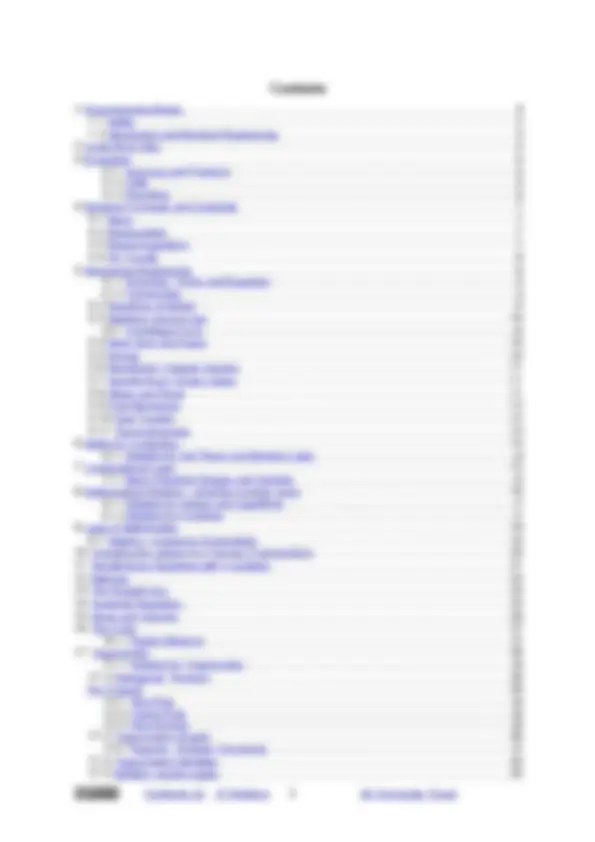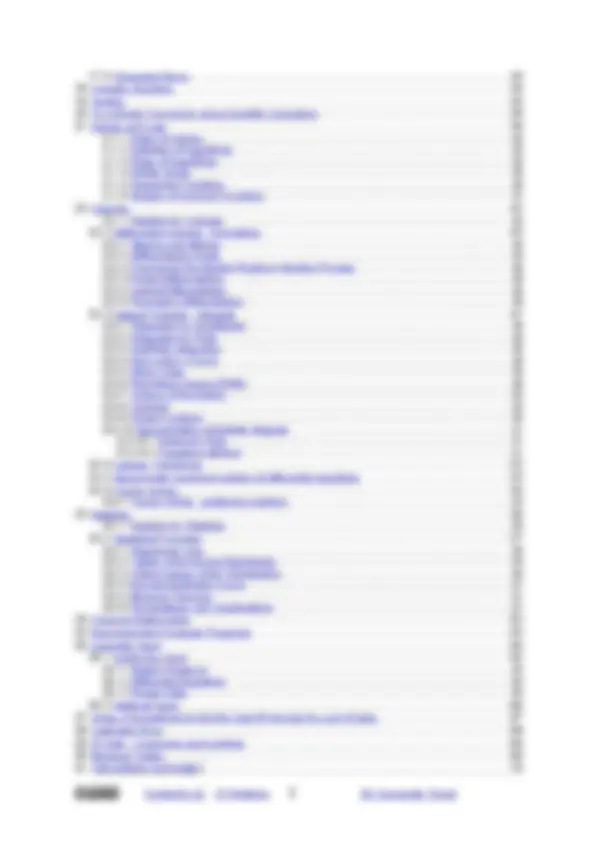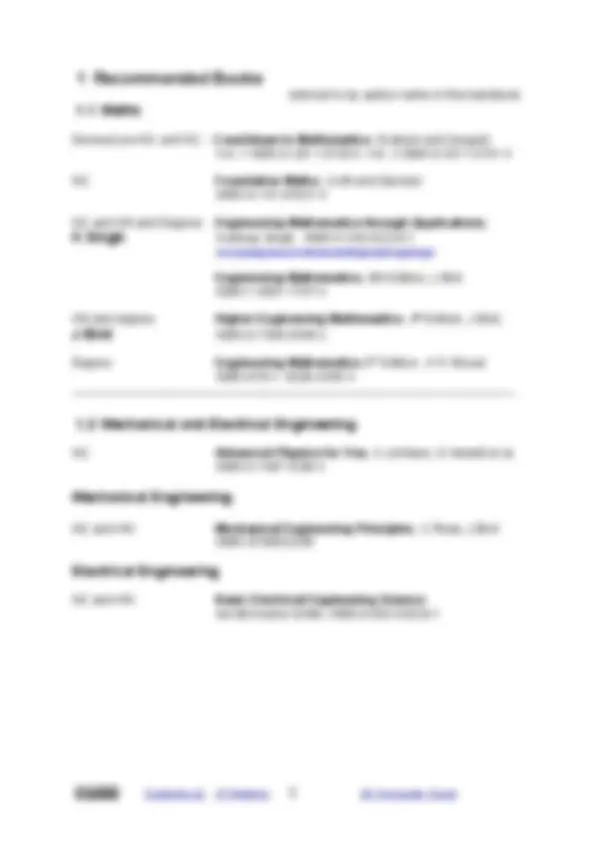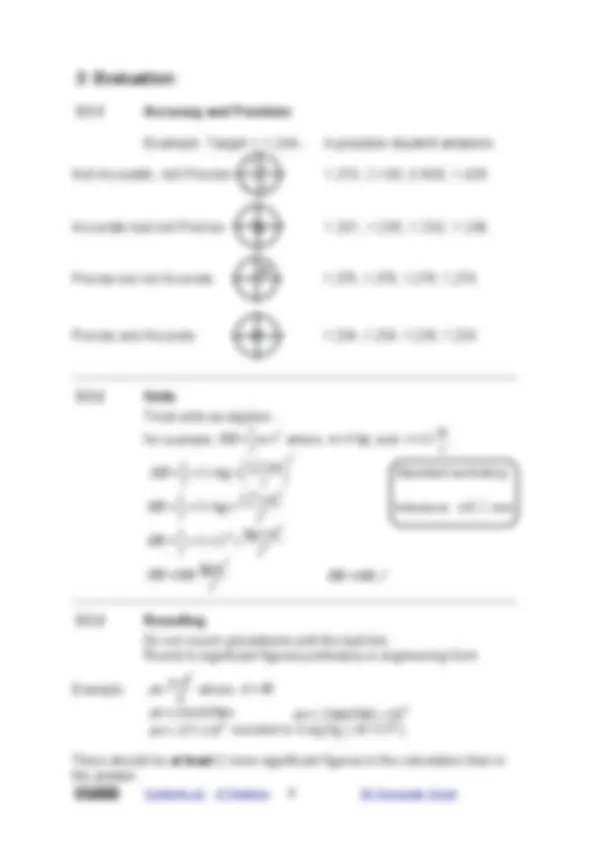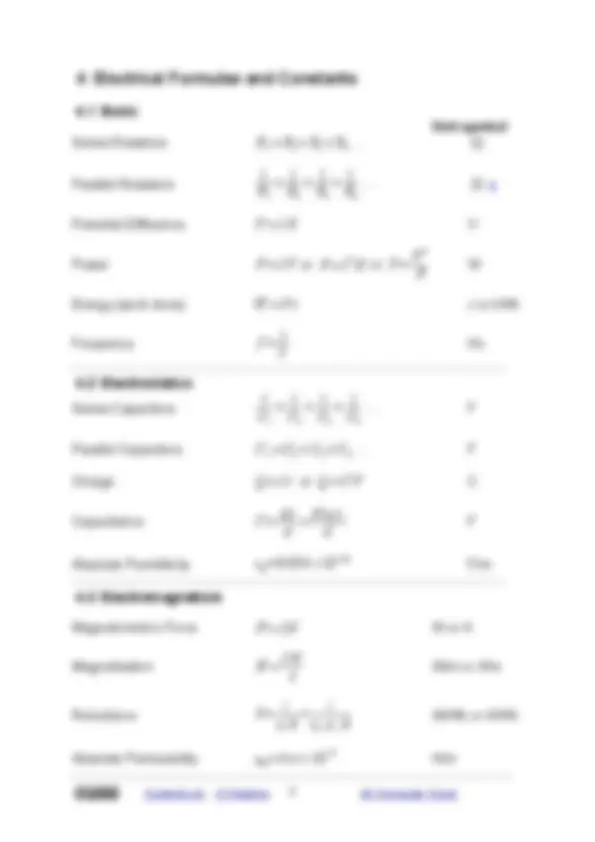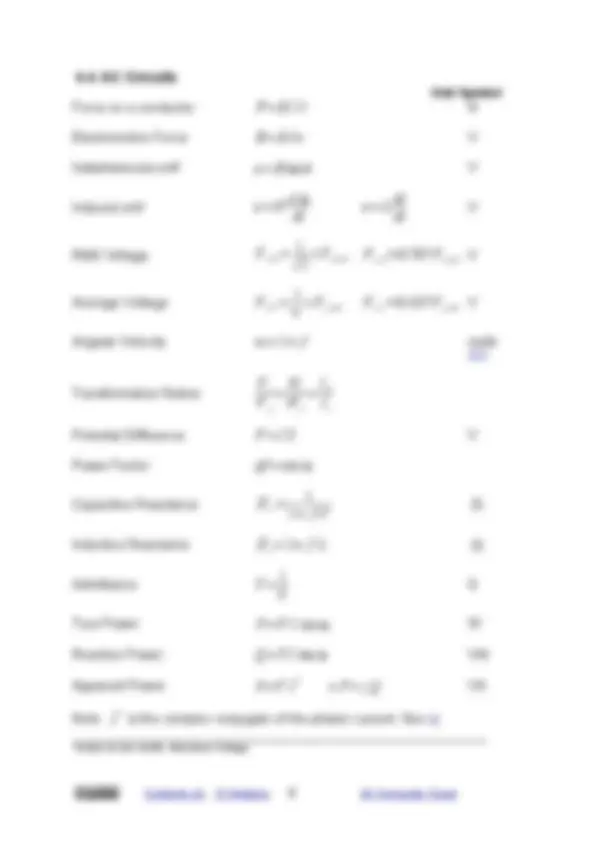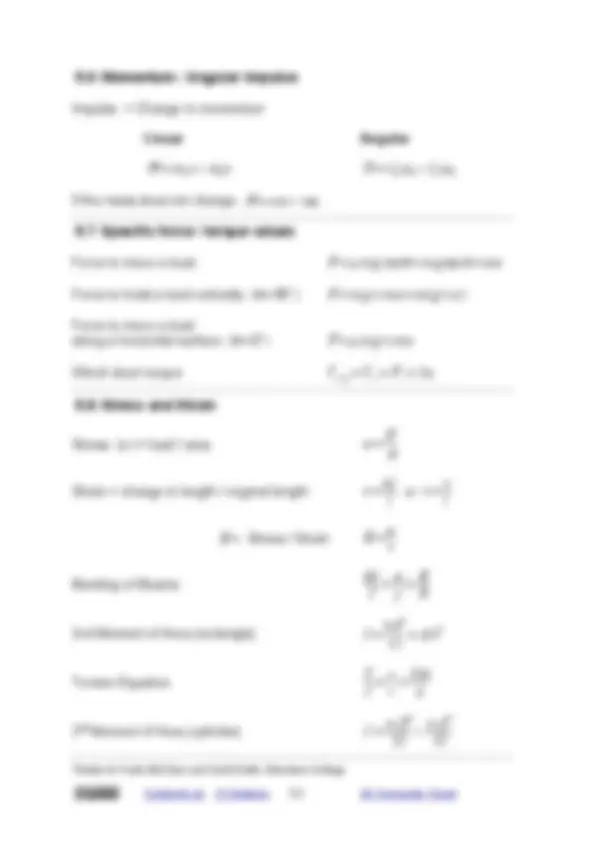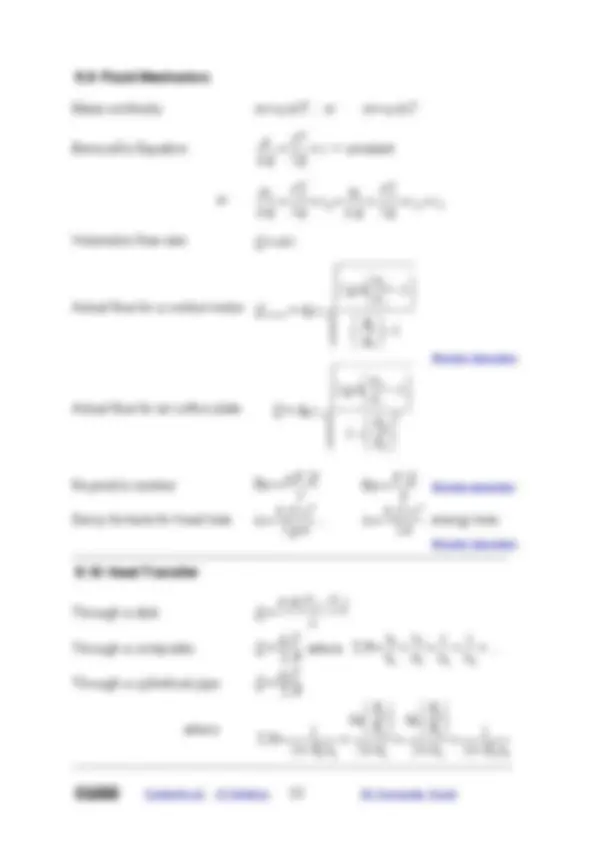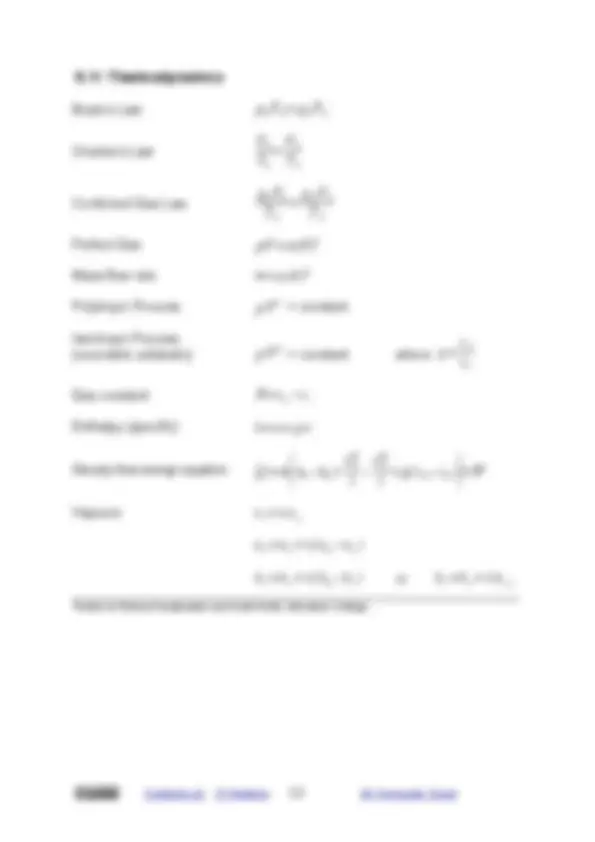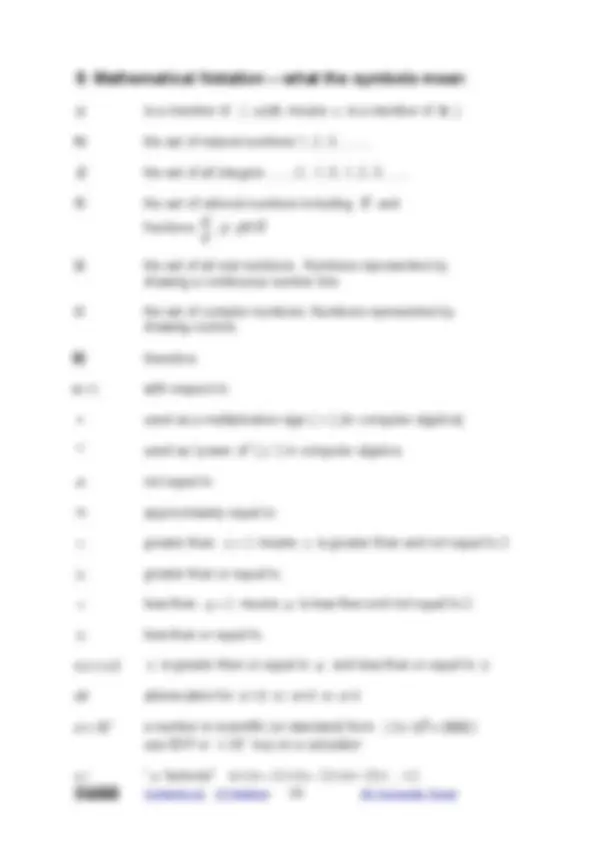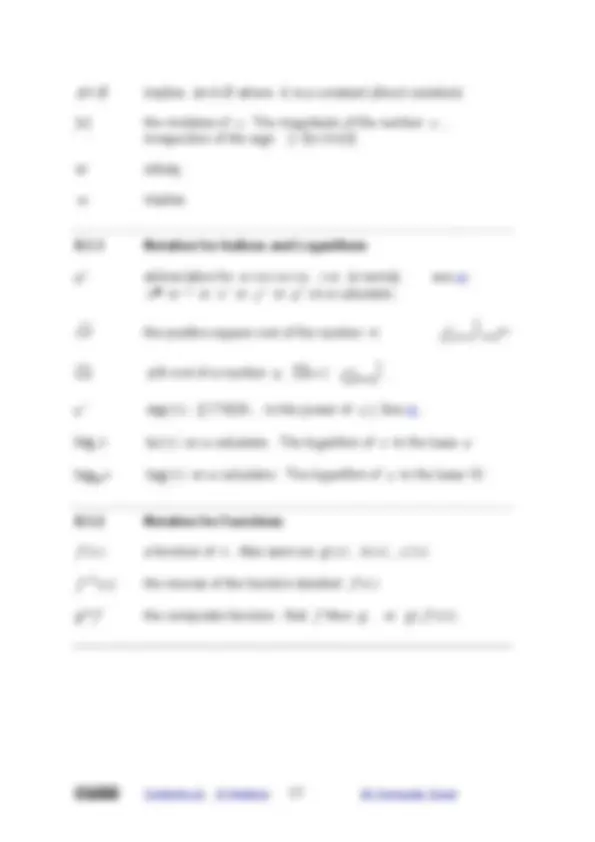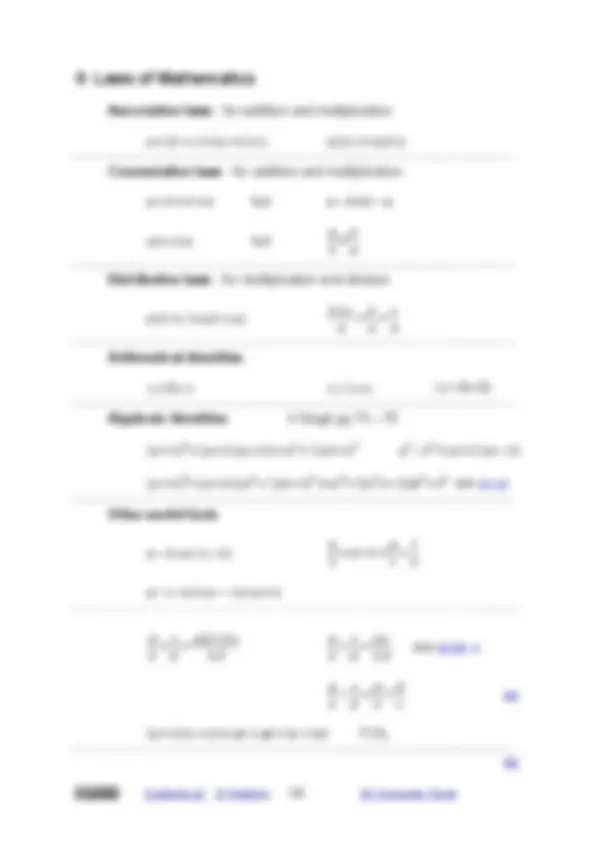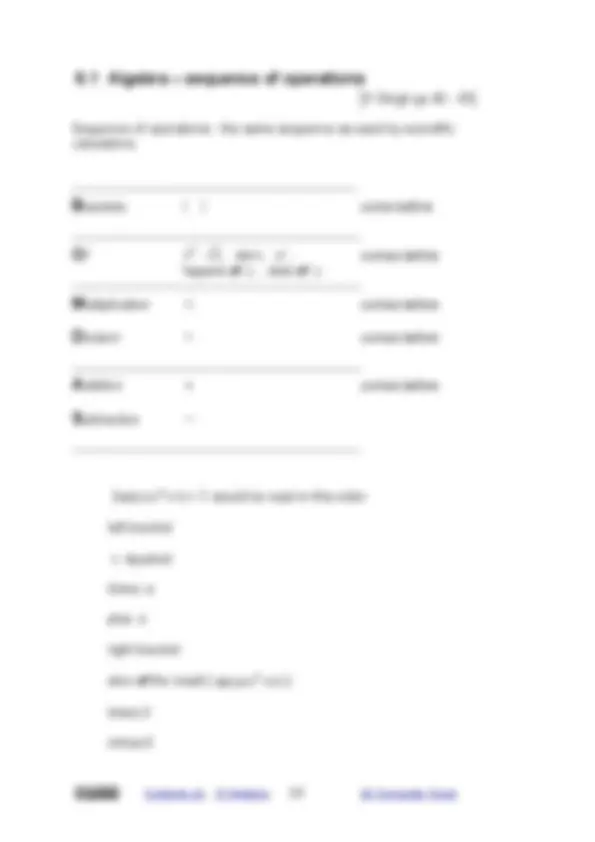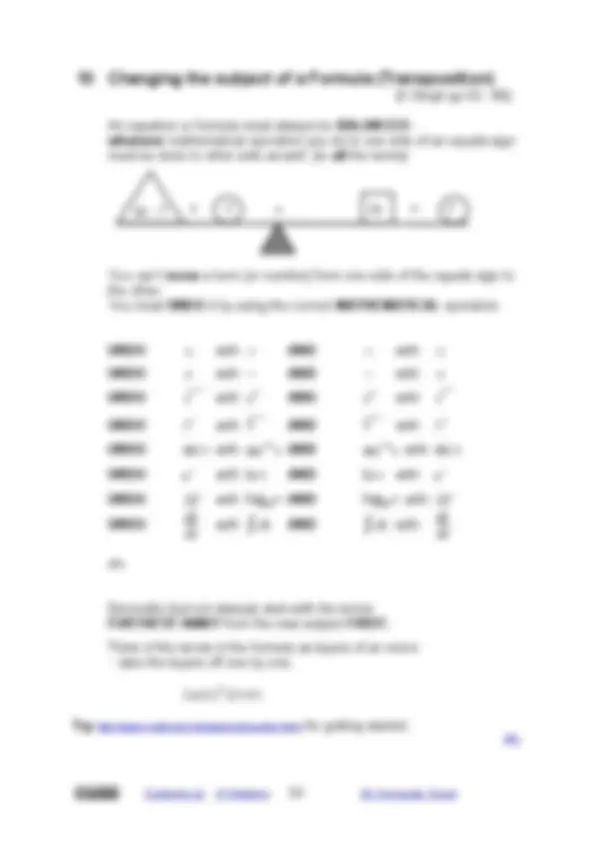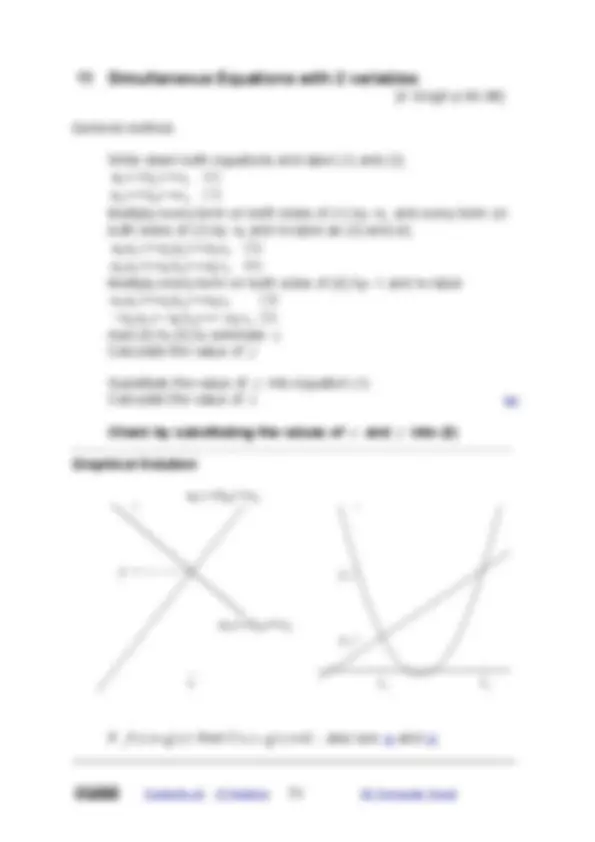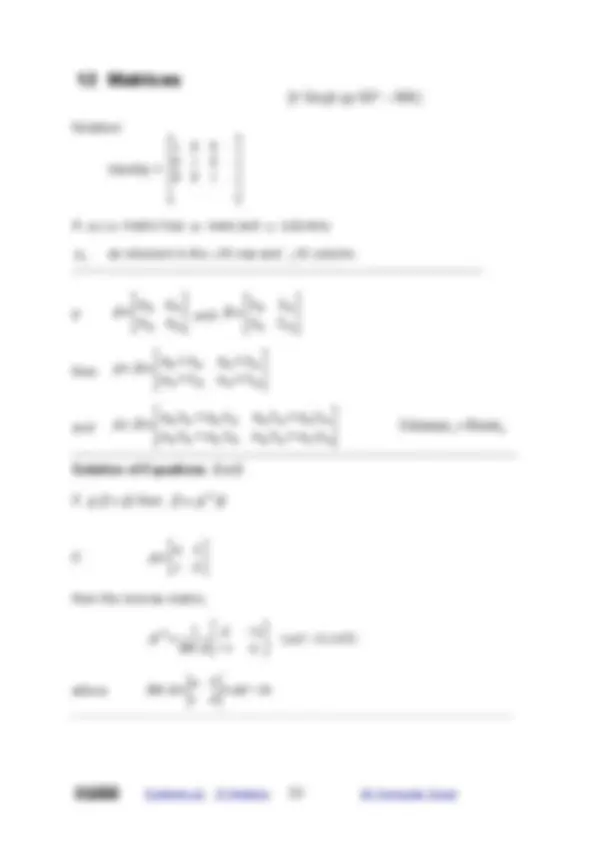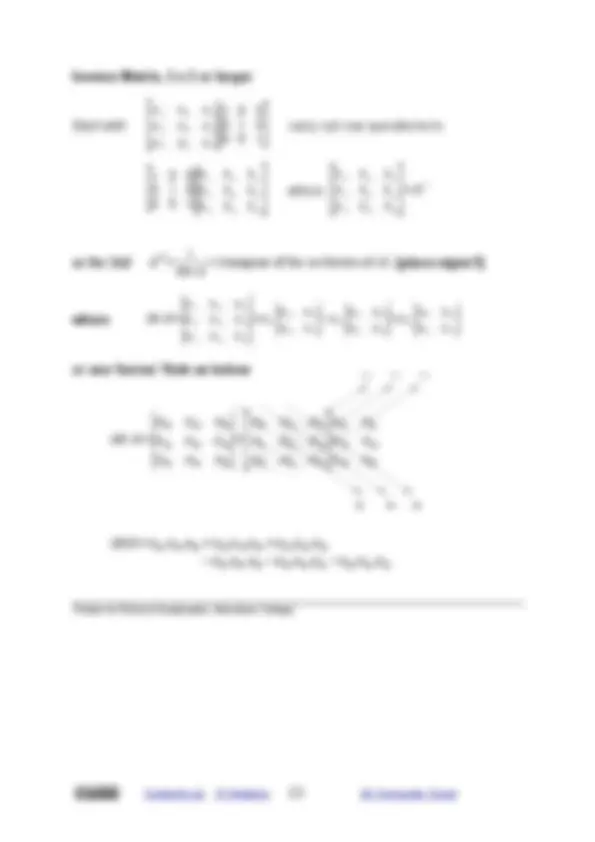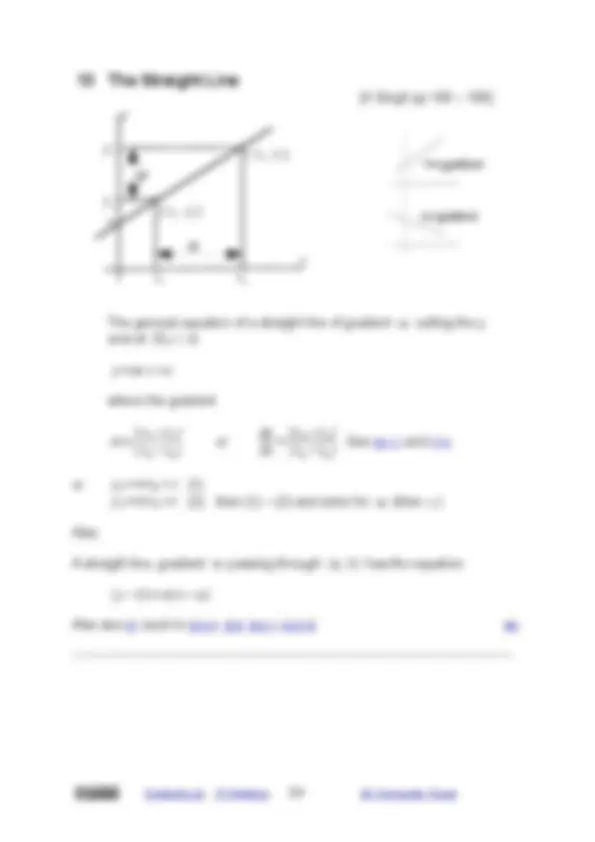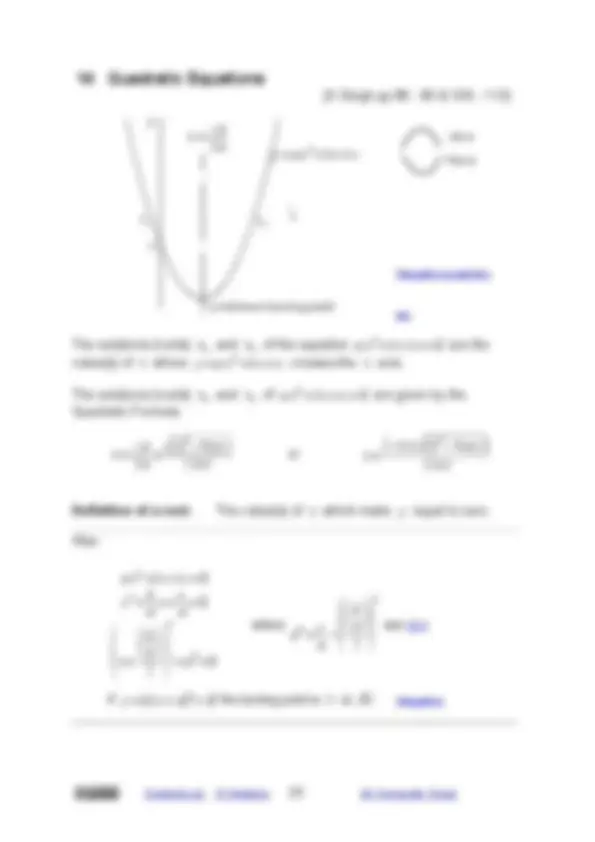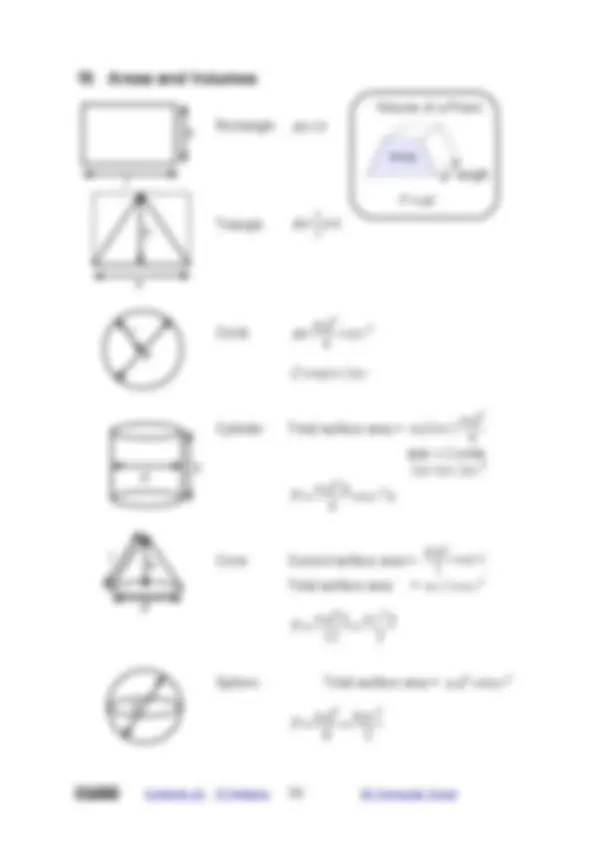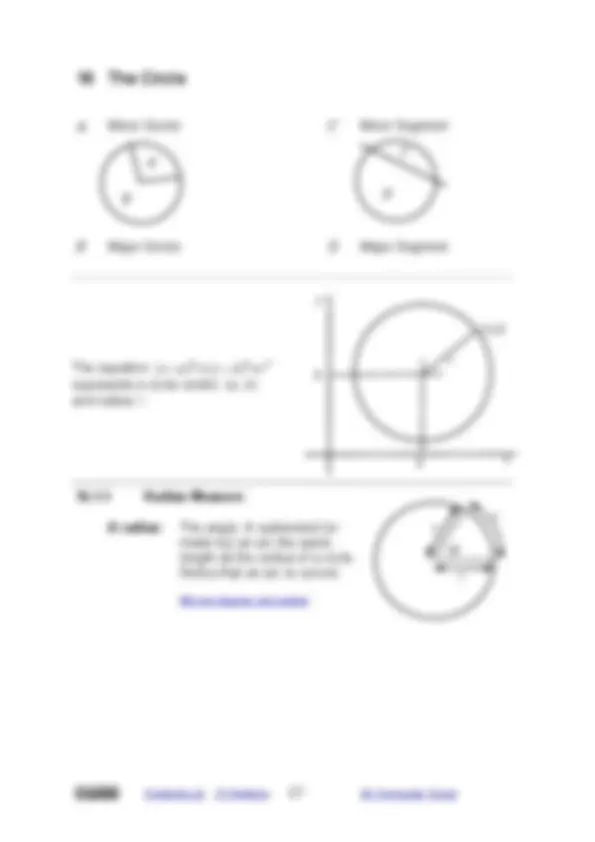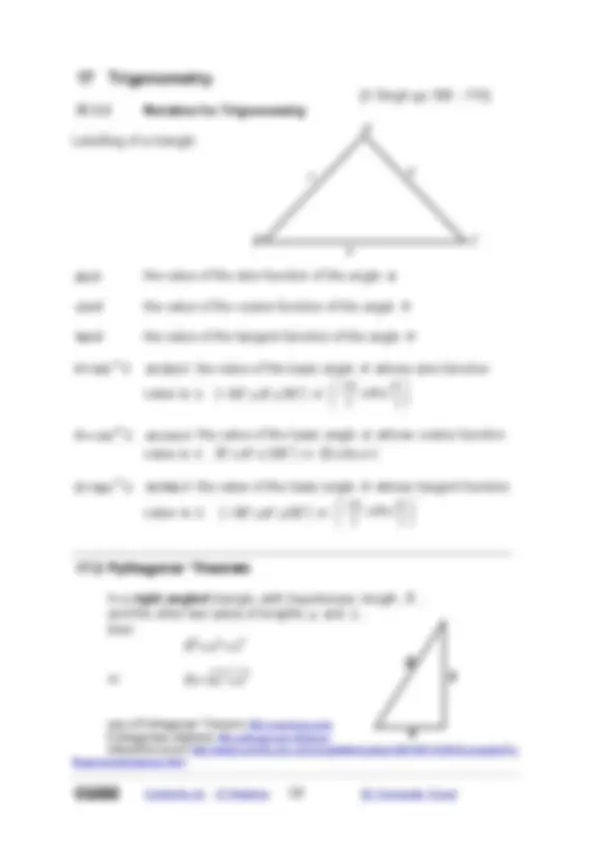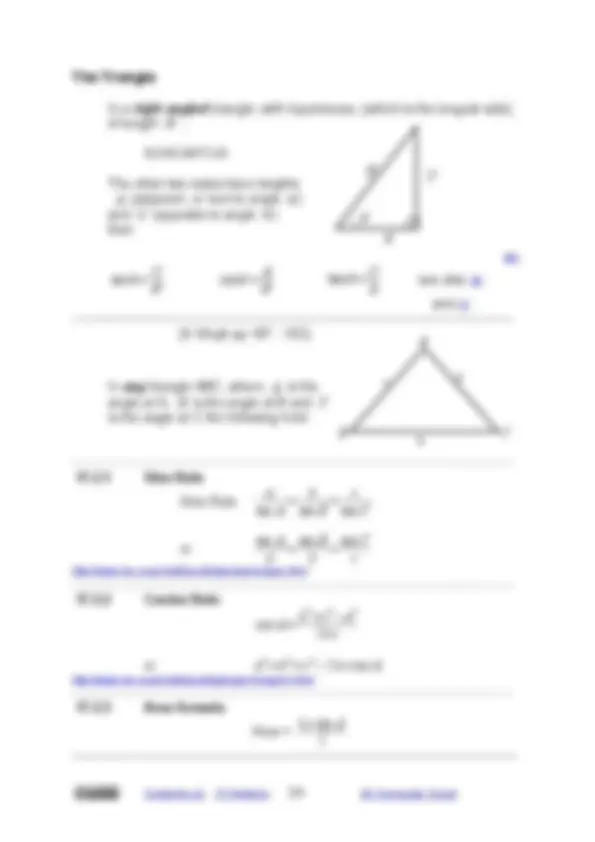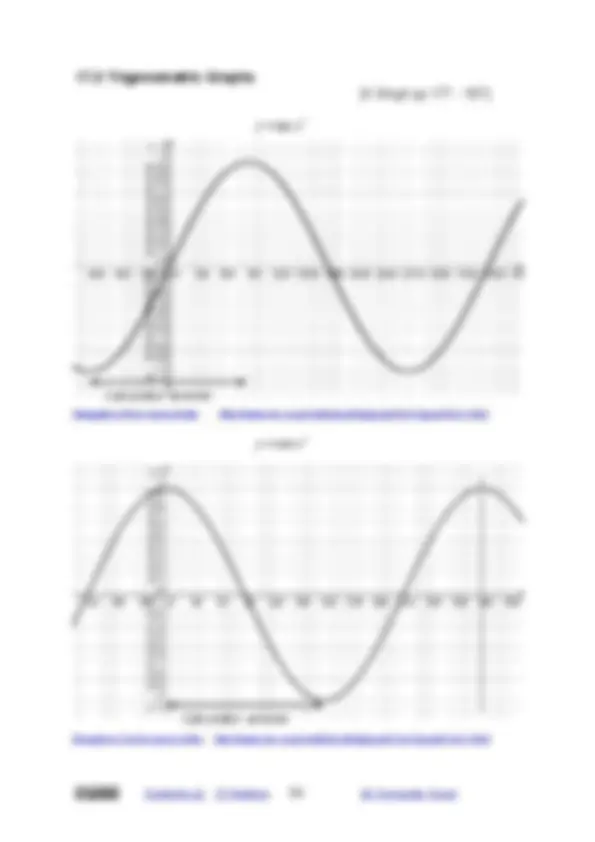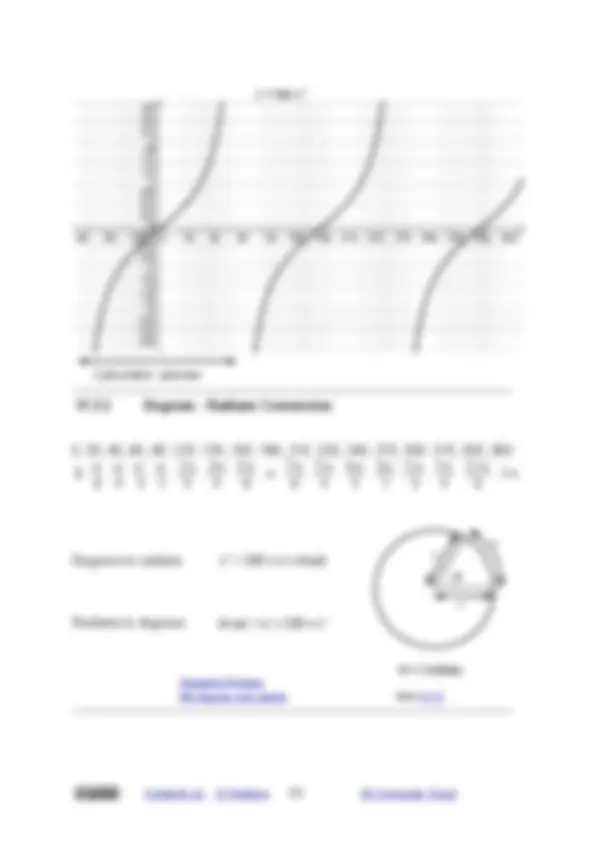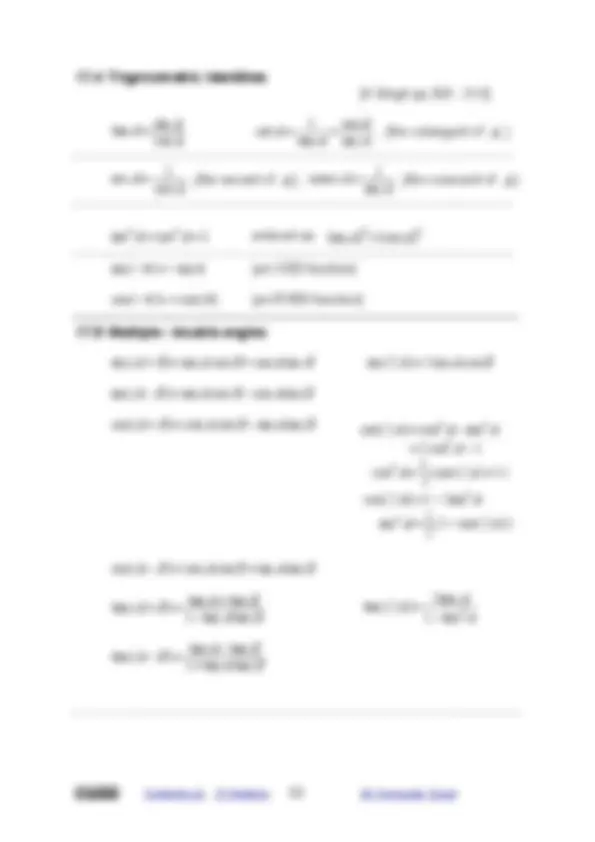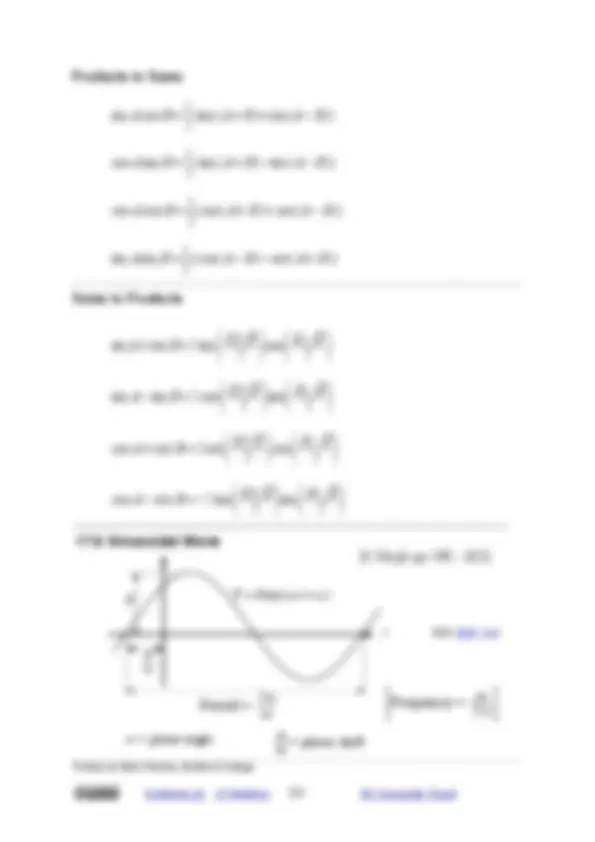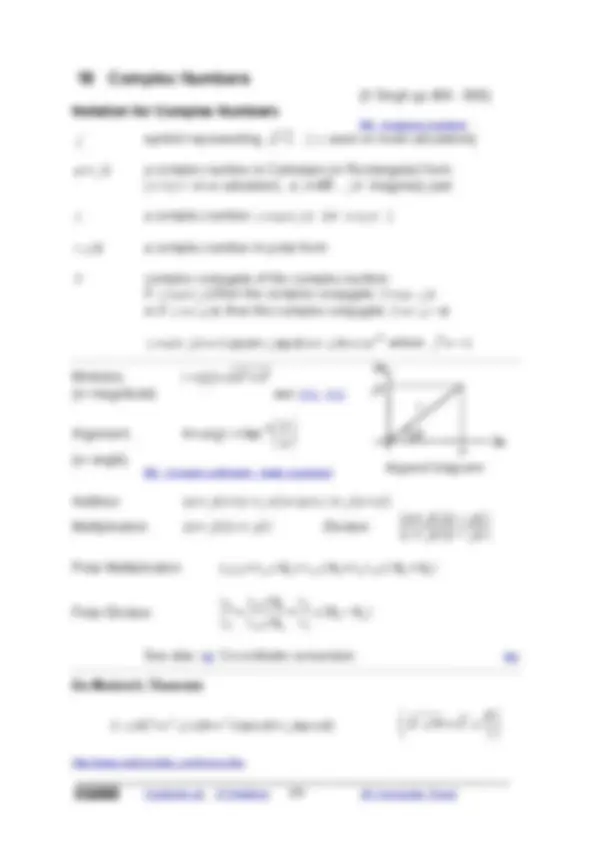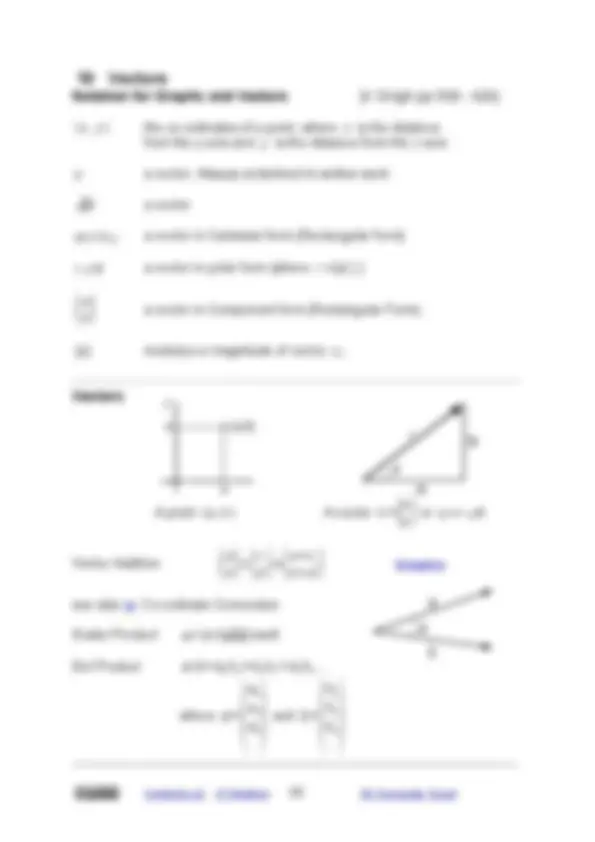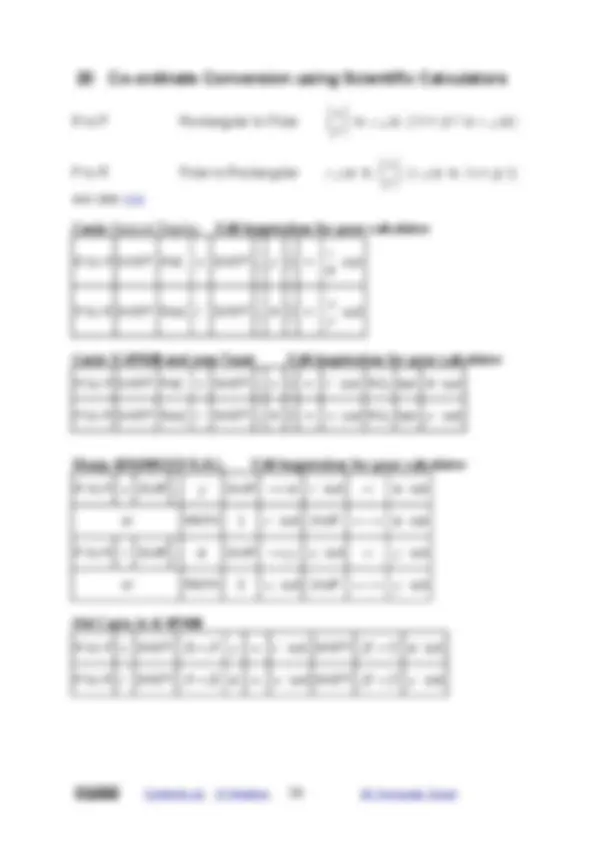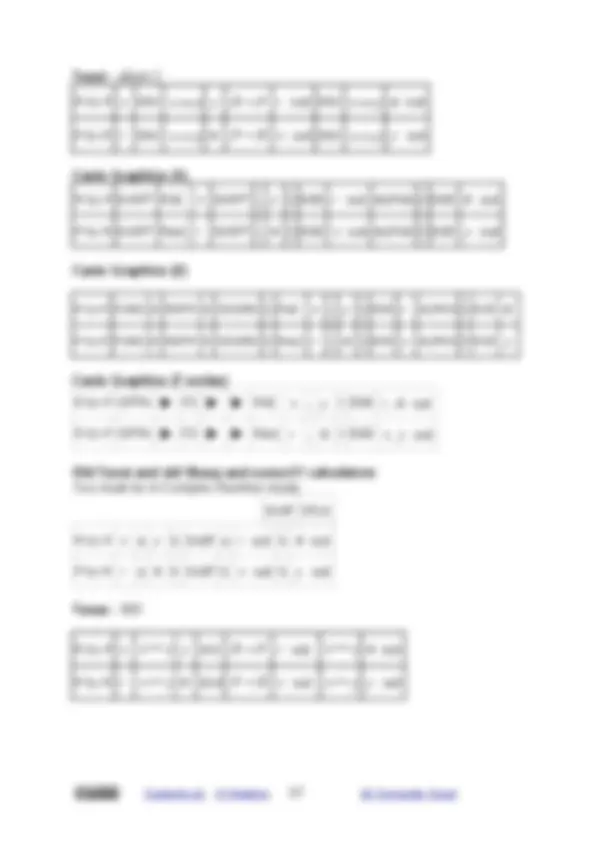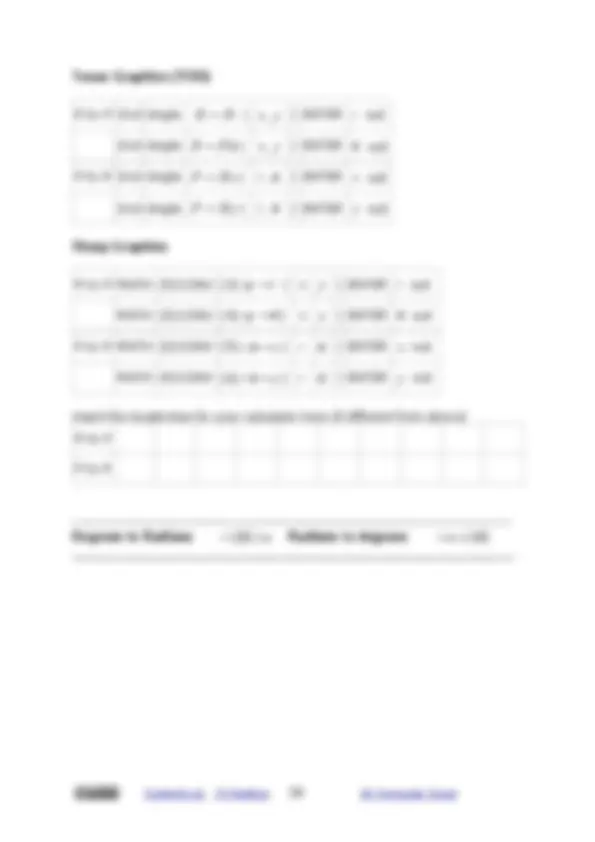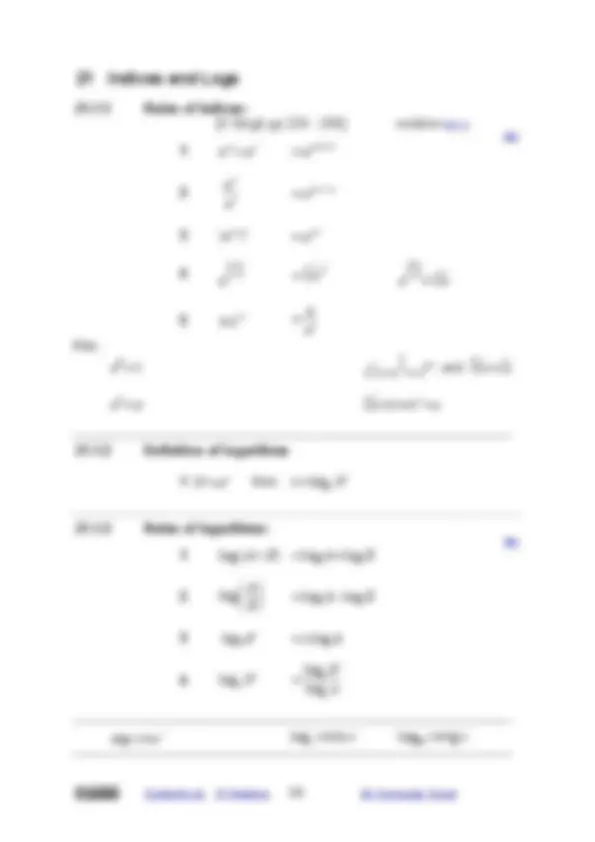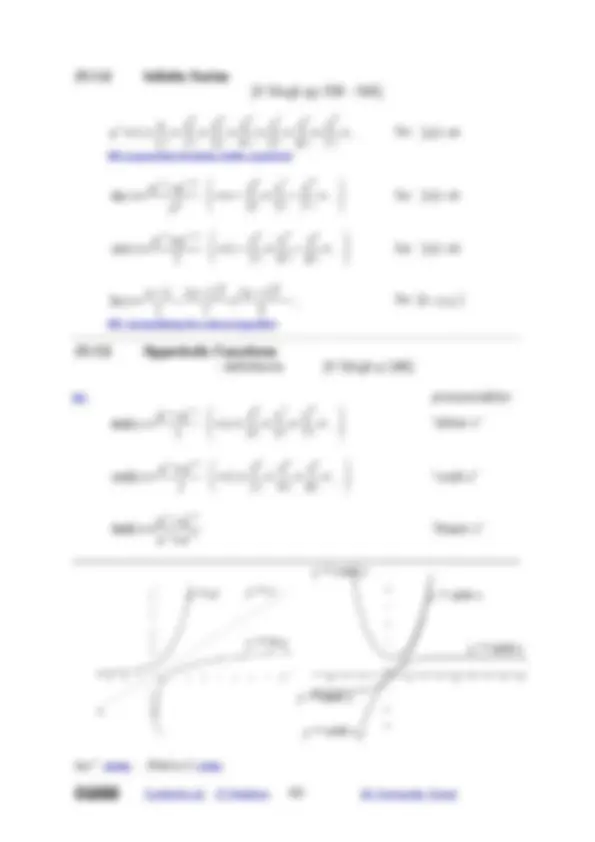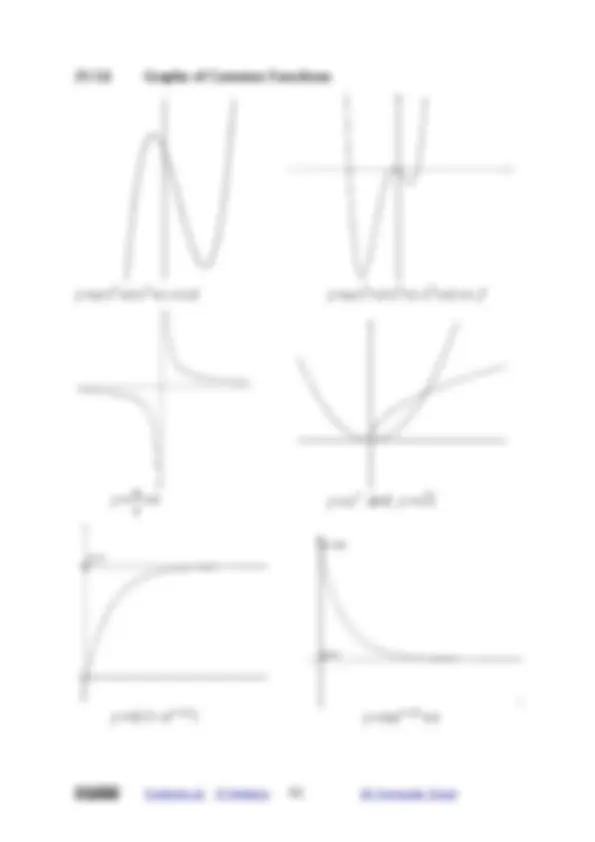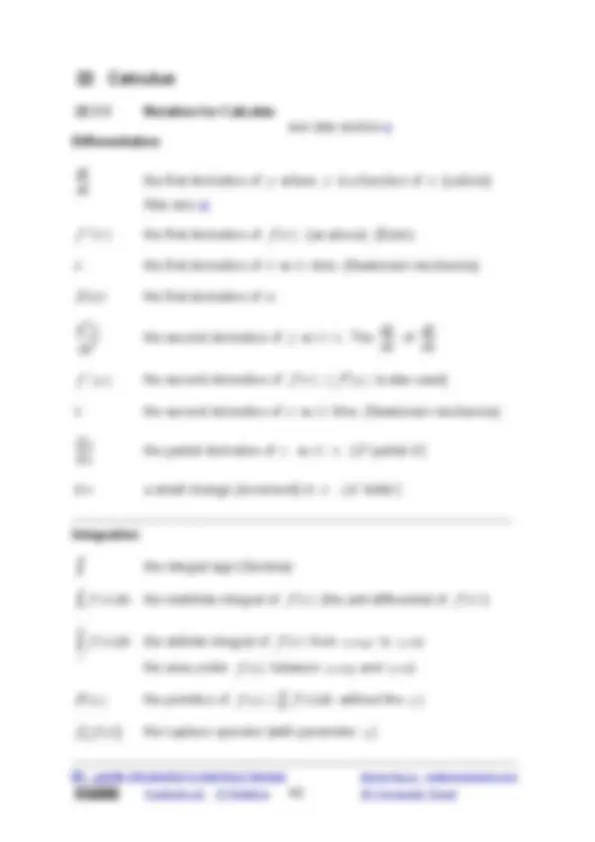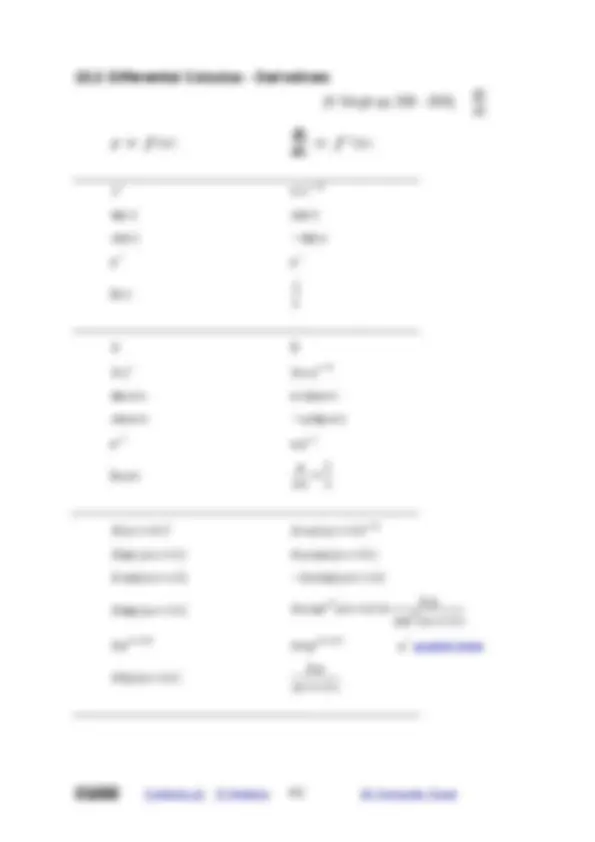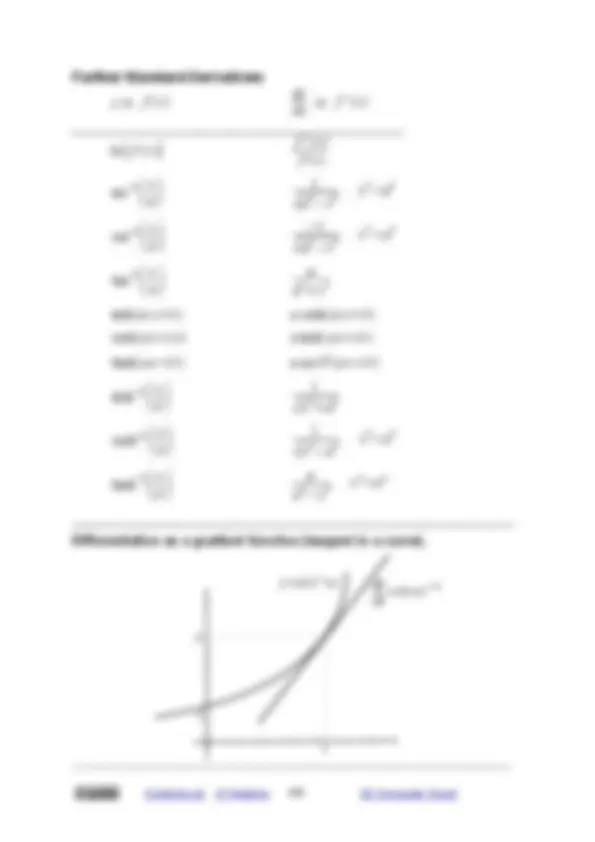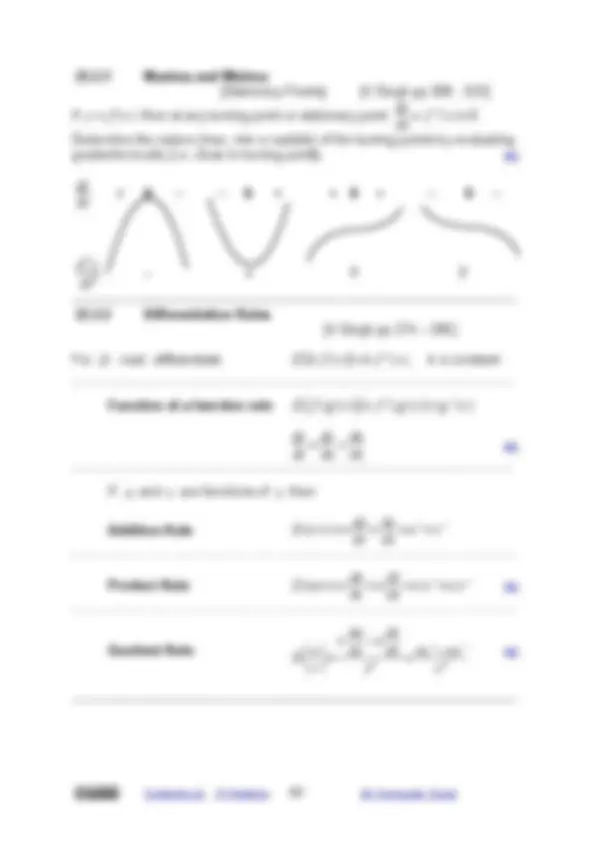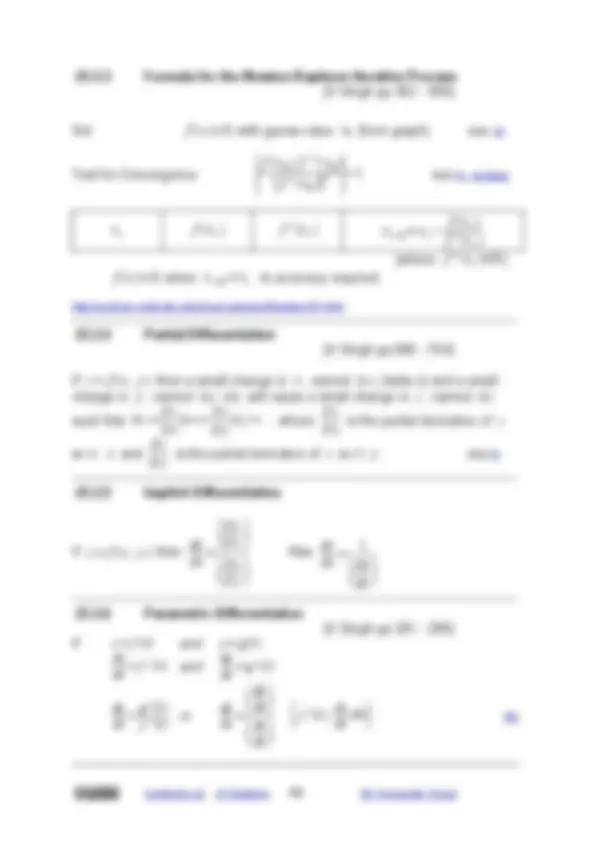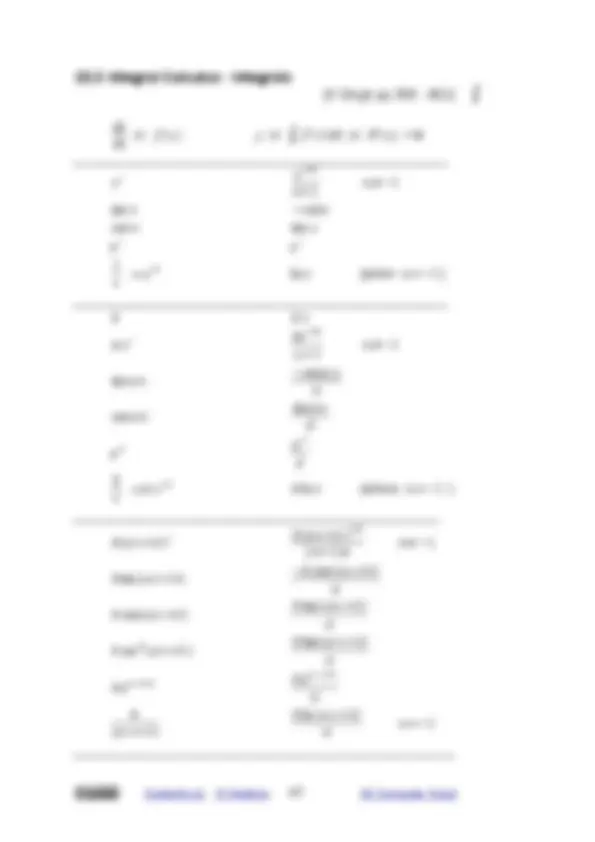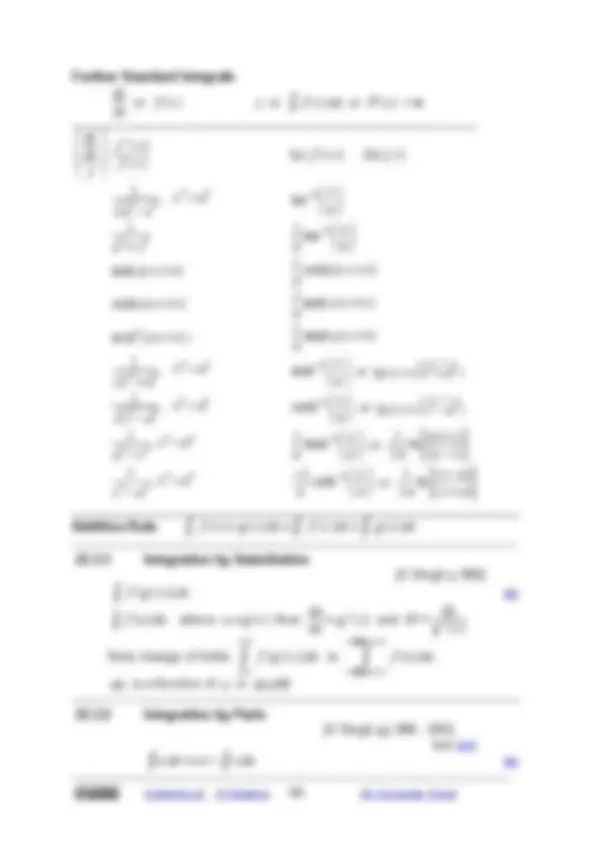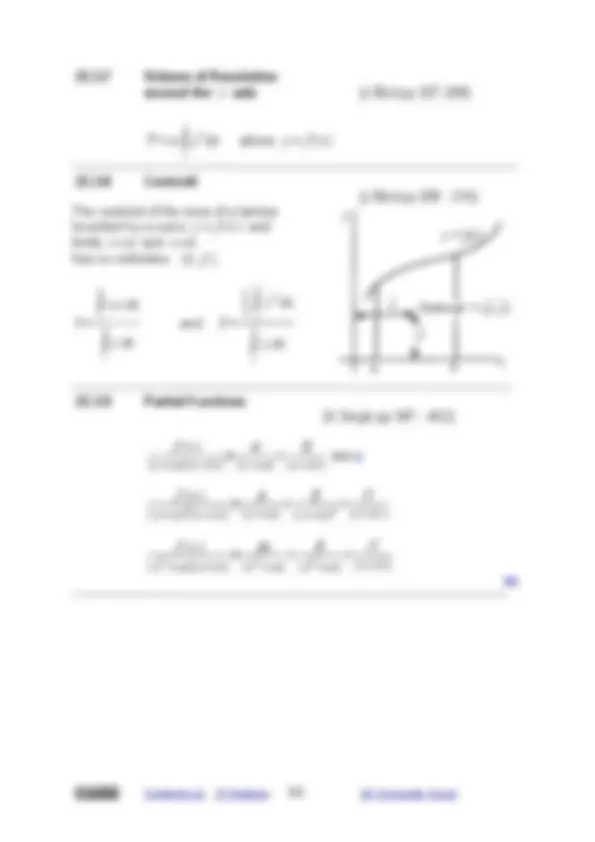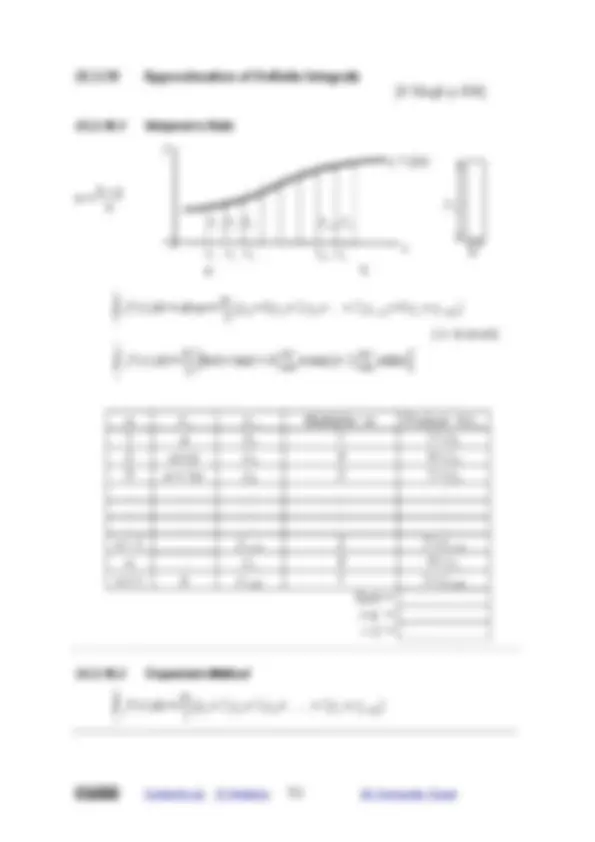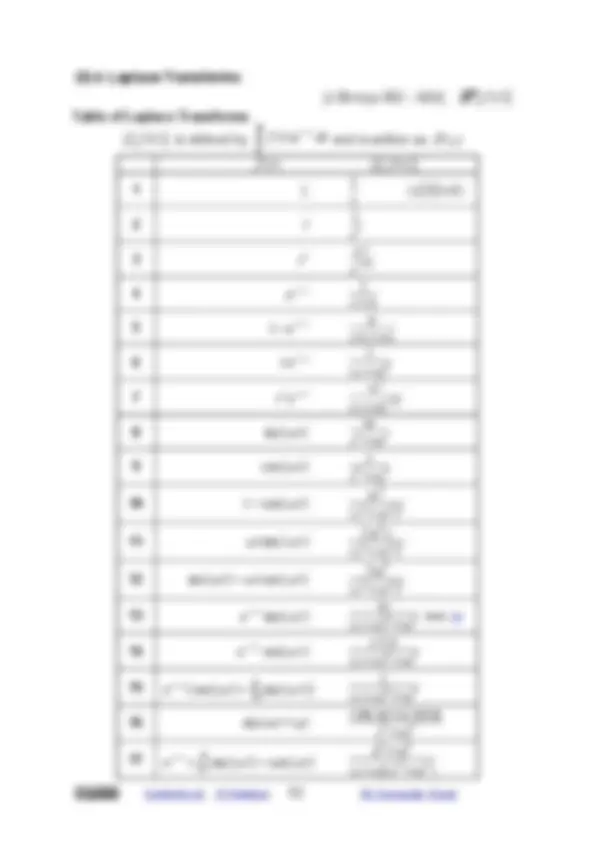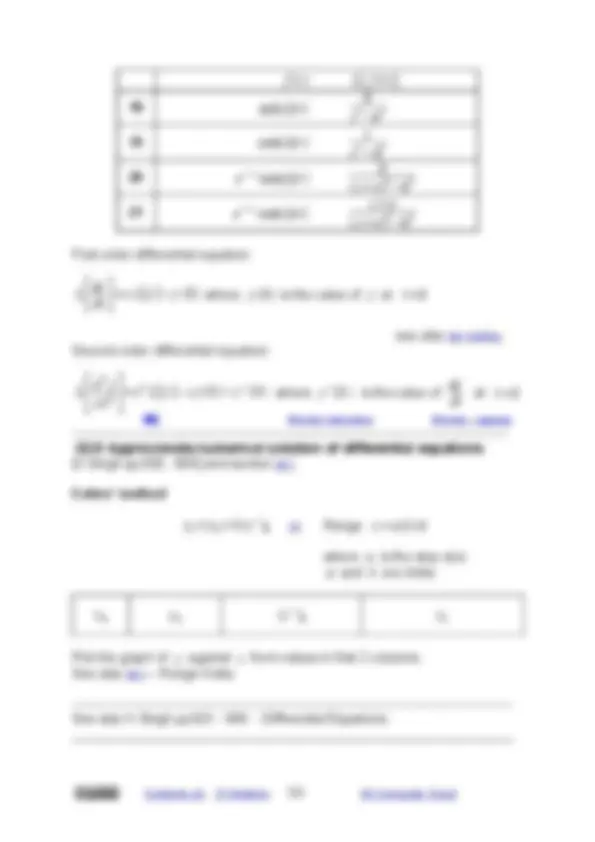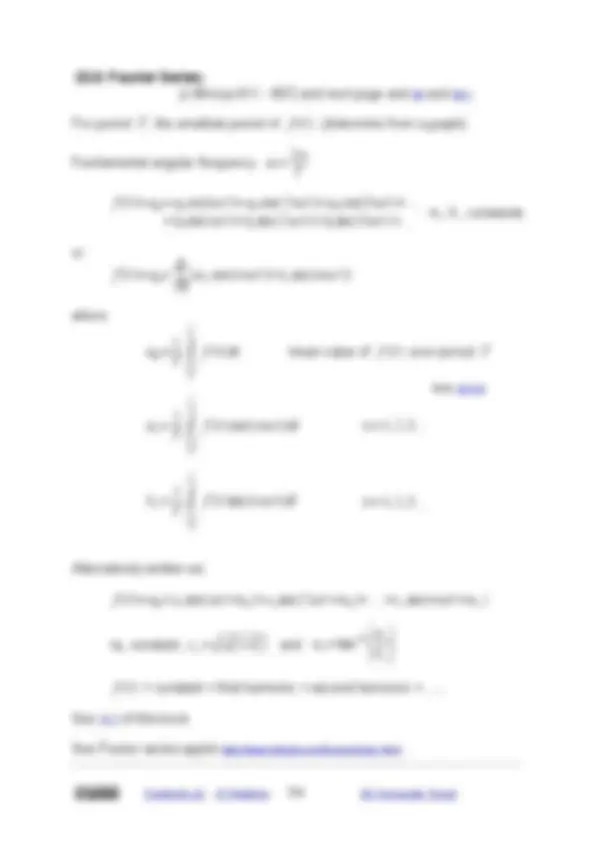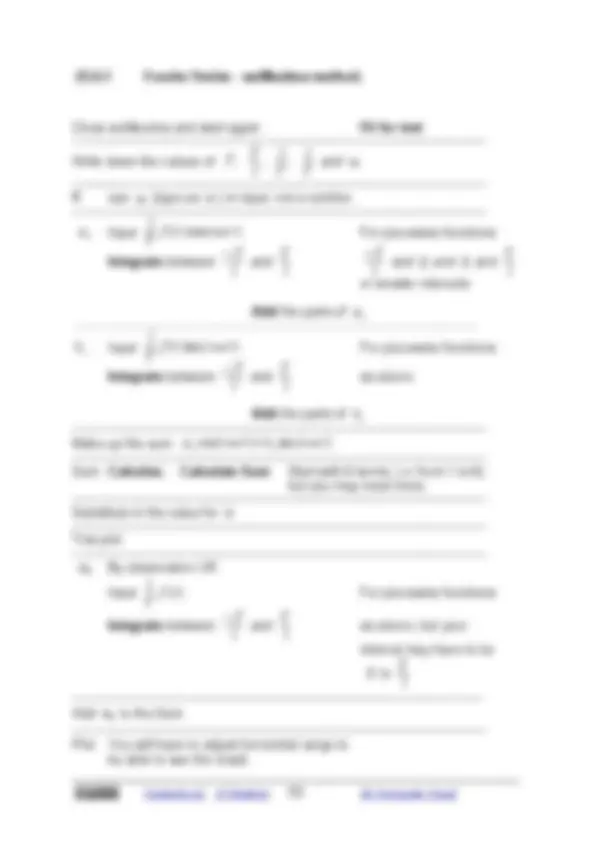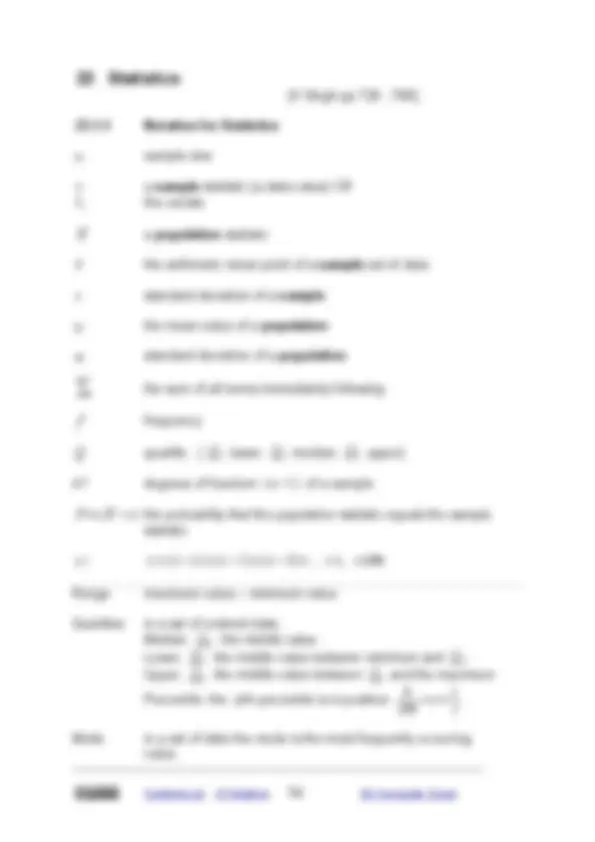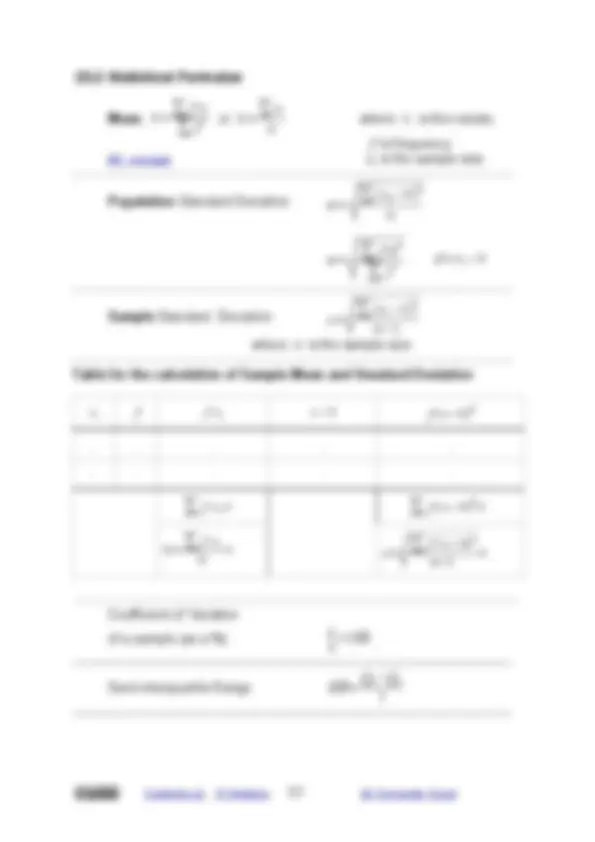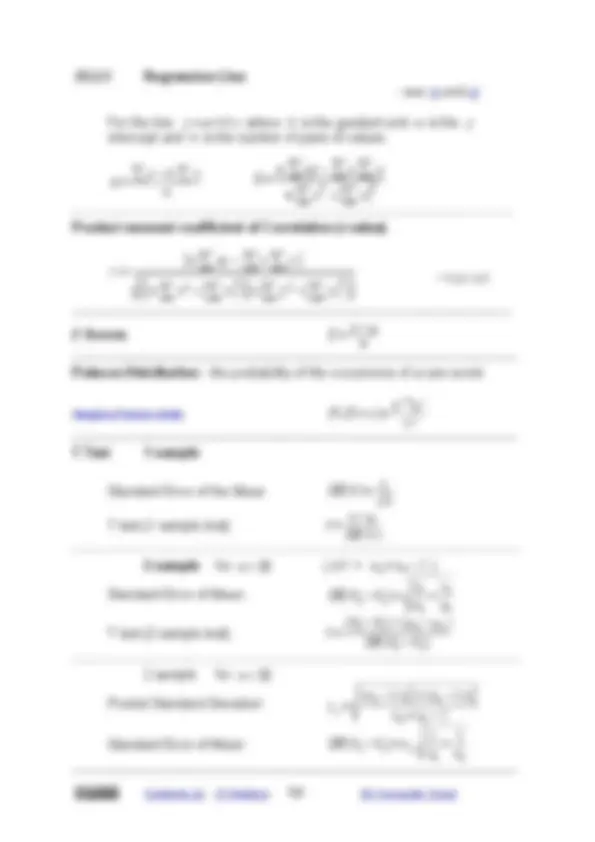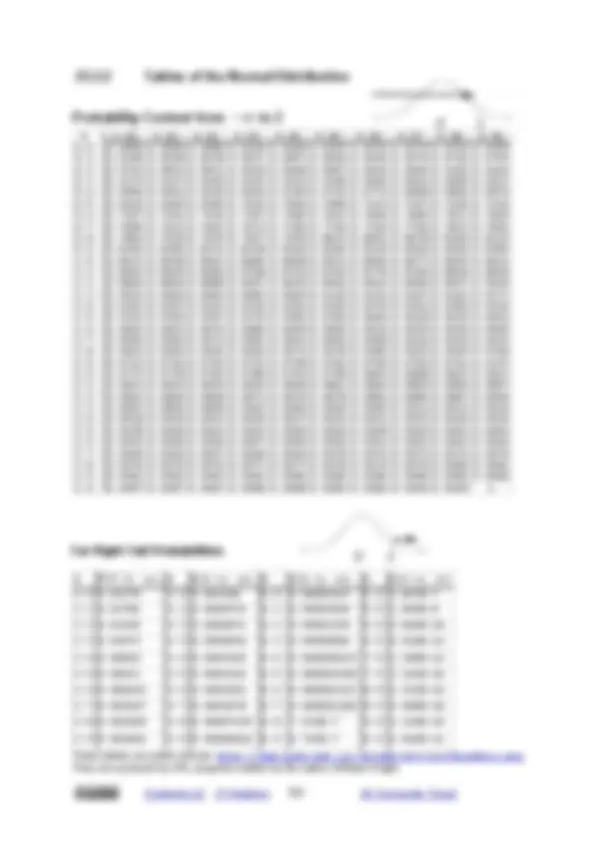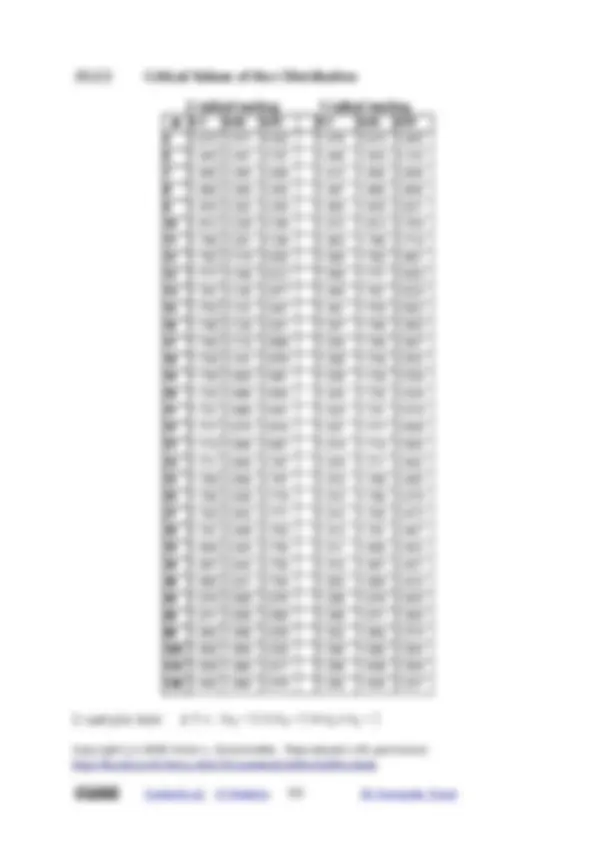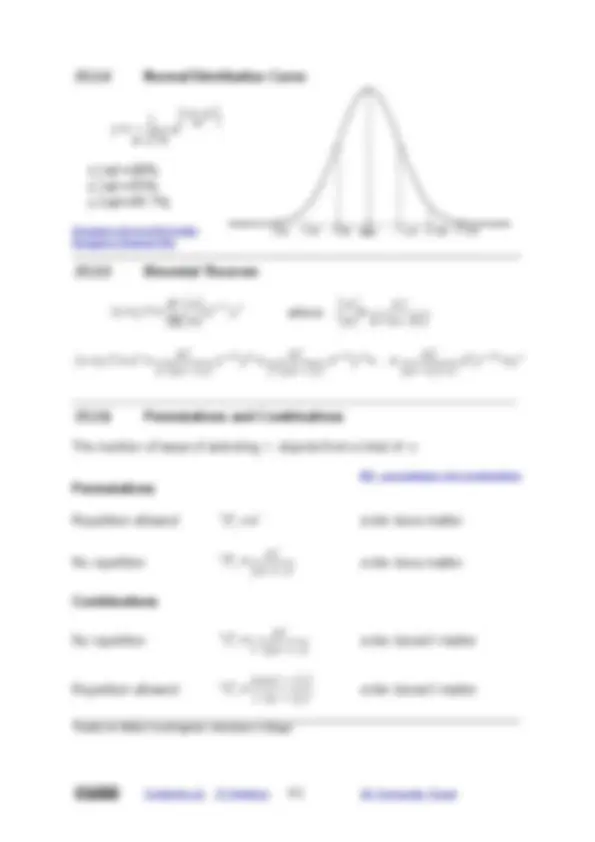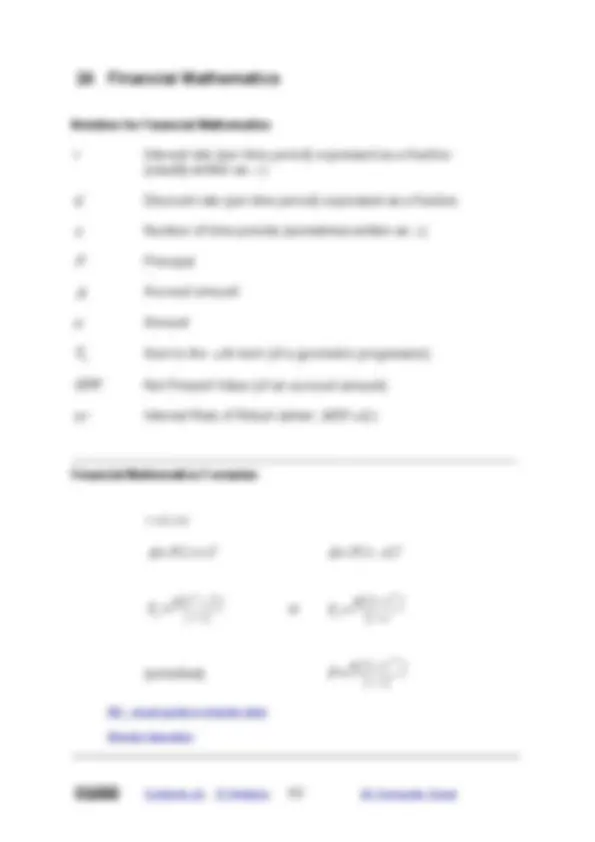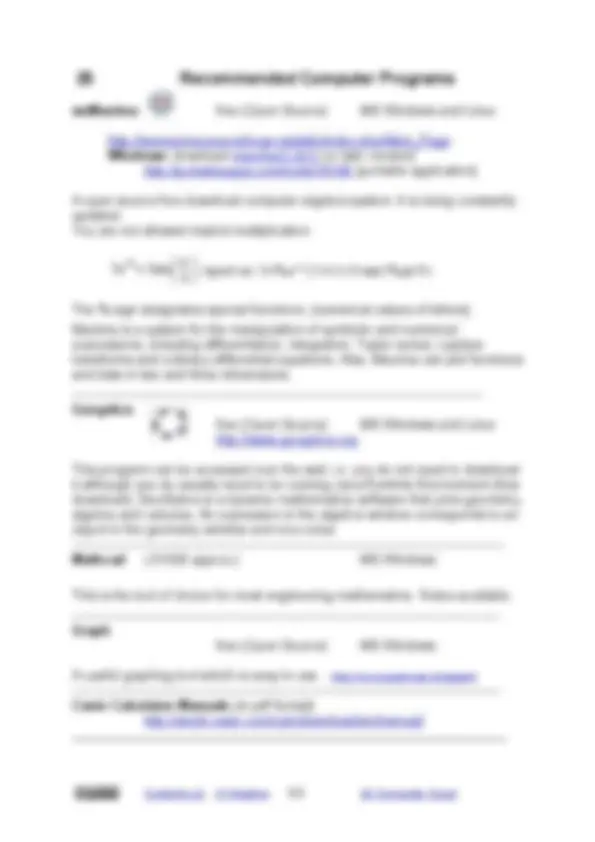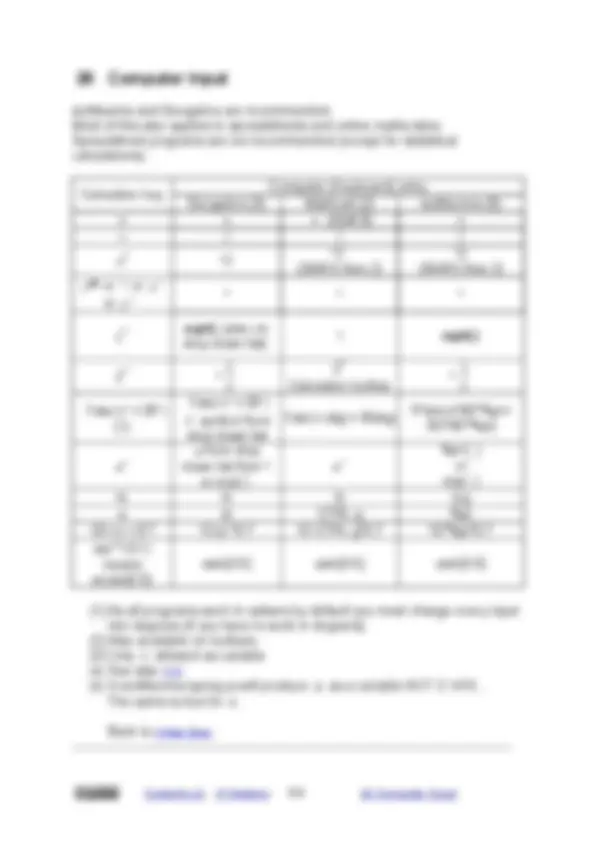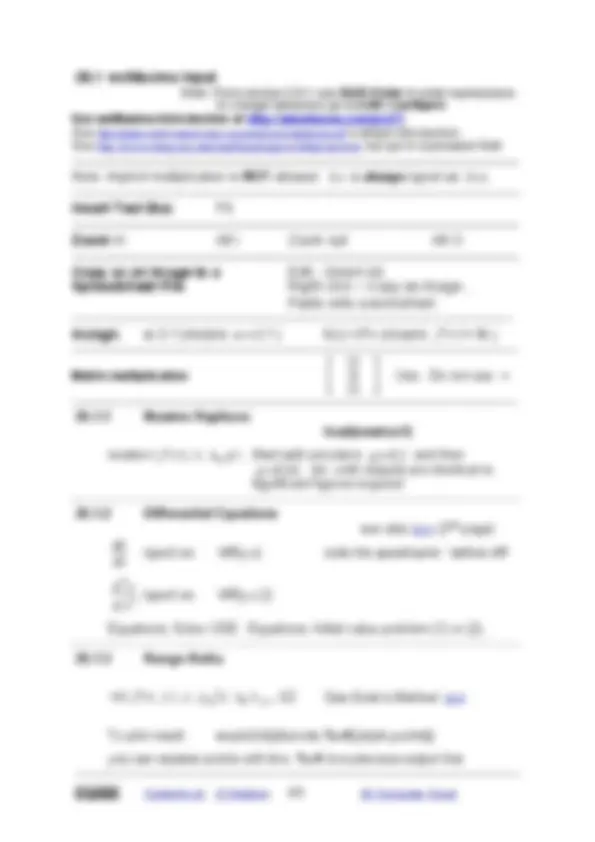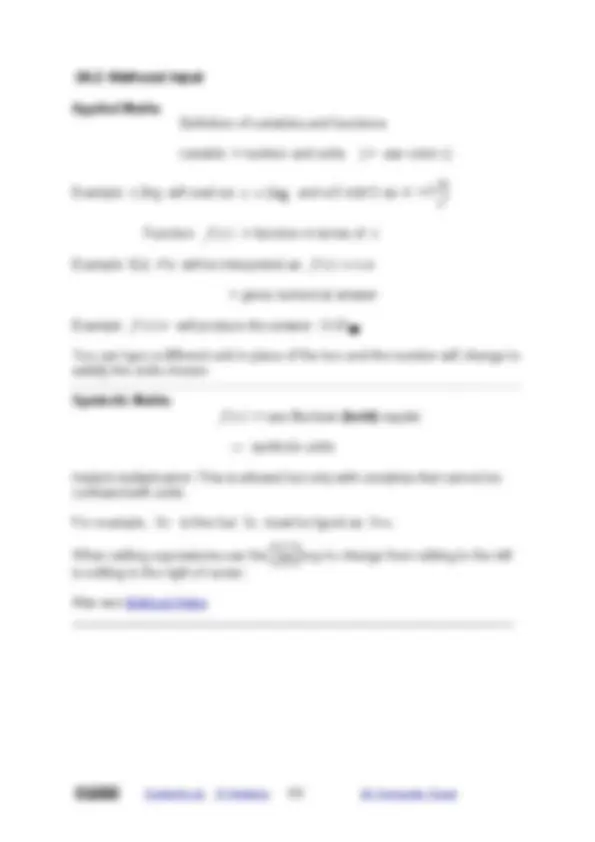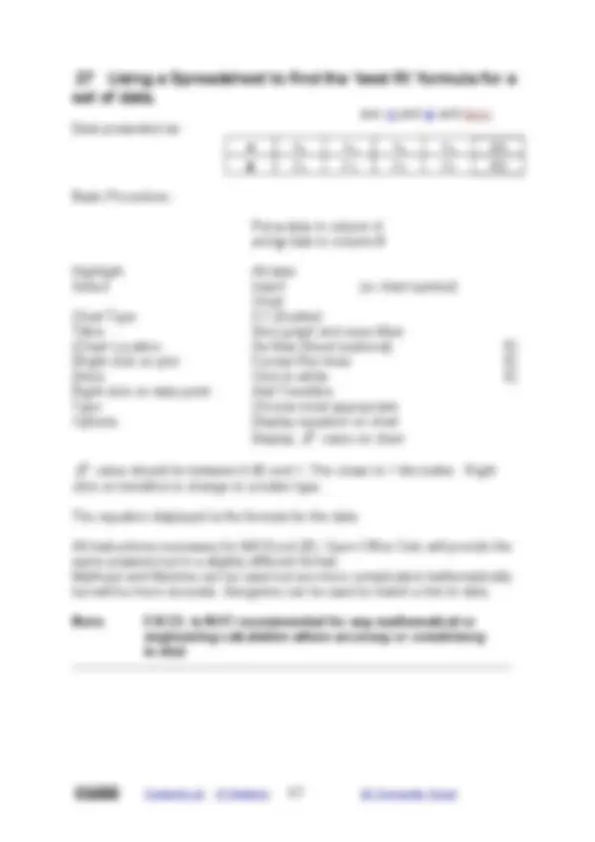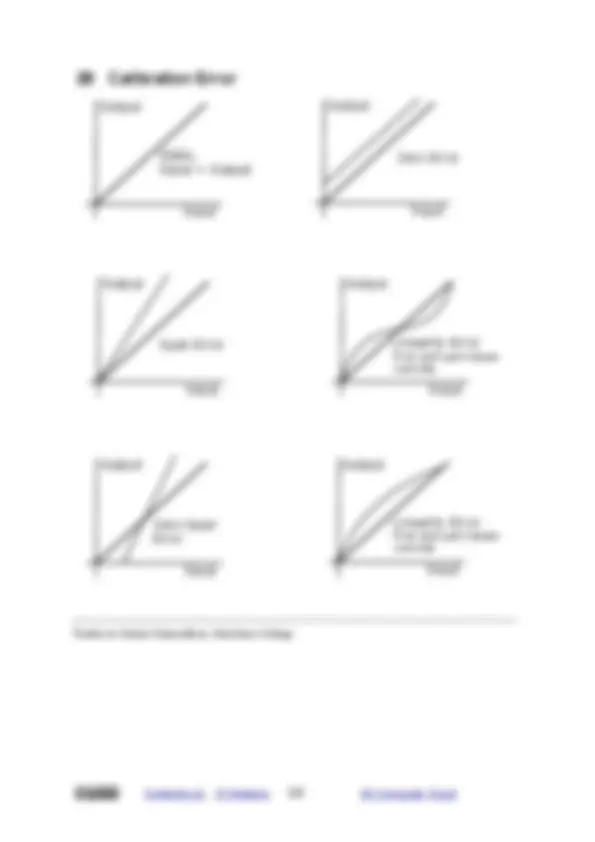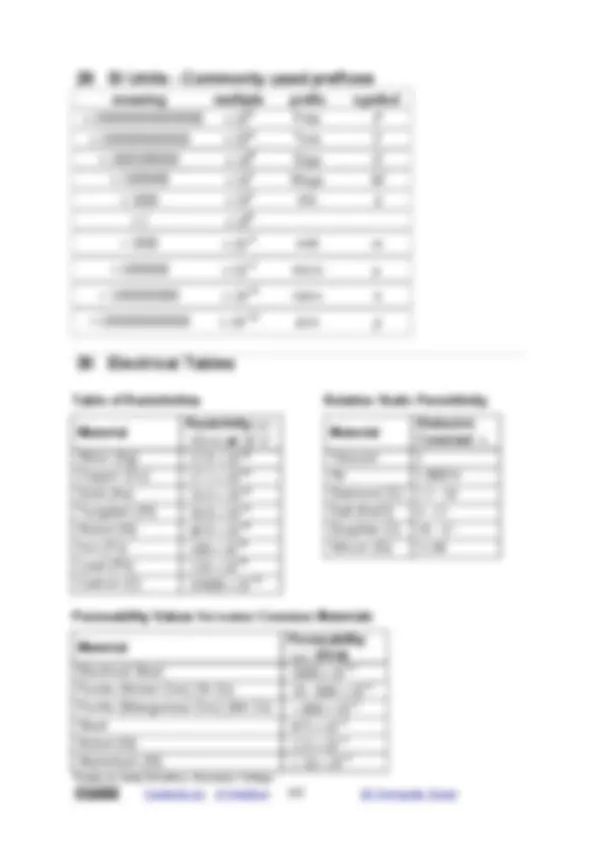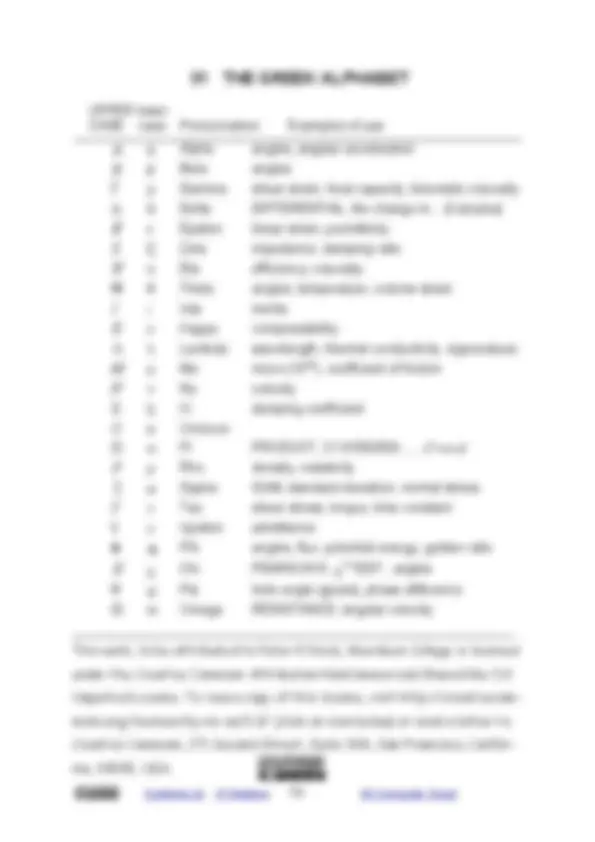Download Formula Handbook and more Study notes Mechanical Engineering in PDF only on Docsity!
6th Edition 2011 350
Name__________________________
Course__________________________
Link to Contents
Introduction
Formula
Handbook
including
Engineering
Formulae,
Mathematics,
Statistics
and
Computer Algebra
http://ubuntuone.com/p/ZOF/ - pdf
http://ubuntuone.com/p/dAn - print
http://ubuntuone.com/p/ZOE/ - OOo (edit)
Introduction
This handbook was designed to provide engineering students at Aberdeen College
with the formulae required for their courses up to Higher National level (2nd year
university equivalent).
In order to use the interactive graphs you will need to have access to Geogebra
(see 25 ). If you are using a MS Windows operating system and you already have
Java Runtime Environment loaded then no changes will be required to the registry.
This should mean that no security issues should be encountered. For Mac and Linux
(and for MS Windows if you have problems)
see http://www.geogebra.org/cms/en/portable
It is typed in Open Office.org. Future developments will include more hyperlinks
within the handbook and to other maths sites, with all the illustrations in it
produced with Geogebra (see 25 ) or OOo.
Any contributions will be gratefully accepted and acknowledged in the handbook.
If you prefer, you can make changes or add to the handbook within the terms of
the Creative Commons licence. Please send me a copy of your work and be
prepared to have it incorporated or adapted for inclusion in my version.
My overriding concern is for the handbook to live on and be continuously improved.
I hope that you find the handbook useful and that you will enjoy using it and that
that you will feel inspired to contribute material and suggest hyperlinks that could
be added.
Many thanks to my colleagues at Aberdeen College for their contributions and help
in editing the handbook. Special thanks are due to Mark Perkins at Bedford College
who adopted the handbook for his students, helped to format the contents and
contributed to the contents. Without Mark's encouragement this project would
have never taken off.
If you find any errors or have suggestions for changes please contact the editor:
Peter K Nicol. (p.nicol@abcol.ac.uk) (peterknicol@gmail.com) Contents
6th Edition XI/MMXI
15/12/
350
- 1 Recommended Books........................................................................................................... - 1.1 Maths........................................................................................................................... - 1.2 Mechanical and Electrical Engineering
- 2 Useful Web Sites..................................................................................................................
- 3 Evaluation............................................................................................................................ - 3.1.1 Accuracy and Precision................................................................................................................... - 3.1.2 Units.................................................................................................................................................... - 3.1.3 Rounding............................................................................................................................................
- 4 Electrical Formulae and Constants - 4.1 Basic - 4.2 Electrostatics................................................................................................................ - 4.3 Electromagnetism - 4.4 AC Circuits
- 5 Mechanical Engineering......................................................................................................... - 5.1.1 Dynamics: Terms and Equations................................................................................................... - 5.1.2 Conversions...................................................................................................................................... - 5.2 Equations of Motion....................................................................................................... - 5.3 Newton's Second Law.................................................................................................. - 5.3.1 Centrifugal Force............................................................................................................................ - 5.4 Work done and Power.................................................................................................. - 5.5 Energy....................................................................................................................... - 5.6 Momentum / Angular Impulse........................................................................................ - 5.7 Specific force / torque values........................................................................................ - 5.8 Stress and Strain......................................................................................................... - 5.9 Fluid Mechanics.......................................................................................................... - 5.10 Heat Transfer............................................................................................................ - 5.11 Thermodynamics.......................................................................................................
- 6 Maths for Computing........................................................................................................... - 6.1.1 Notation for Set Theory and Boolean Laws
- 7 Combinational Logic............................................................................................................ - 7.1.1 Basic Flowchart Shapes and Symbols........................................................................................
- 8 Mathematical Notation – what the symbols mean.................................................................... - 8.1.1 Notation for Indices and Logarithms............................................................................................ - 8.1.2 Notation for Functions....................................................................................................................
- 9 Laws of Mathematics........................................................................................................... - 9.1 Algebra – sequence of operations.................................................................................
- 10 Changing the subject of a Formula (Transposition)................................................................
- 11 Simultaneous Equations with 2 variables.............................................................................
- 12 Matrices
- 13 The Straight Line
- 14 Quadratic Equations
- 15 Areas and Volumes...........................................................................................................
- 16 The Circle......................................................................................................................... - 16.1.1 Radian Measure...........................................................................................................................
- 17 Trigonometry.................................................................................................................... - 17.1.1 Notation for Trigonometry........................................................................................................... - 17.2 Pythagoras’ Theorem.................................................................................................
- The Triangle...................................................................................................................... - 17.2.1 Sine Rule....................................................................................................................................... - 17.2.2 Cosine Rule................................................................................................................................... - 17.2.3 Area formula..................................................................................................................................
- 17.3 Trigonometric Graphs................................................................................................
- 17.3.1 Degrees - Radians Conversion..................................................................................................
- 17.4 Trigonometric Identities..............................................................................................
- 17.5 Multiple / double angles..............................................................................................
- 17.6 Sinusoidal Wave........................................................................................................
- 18 Complex Numbers.............................................................................................................
- 19 Vectors............................................................................................................................
- 20 Co-ordinate Conversion using Scientific Calculators..............................................................
- 21 Indices and Logs............................................................................................................... - 21.1.1 Rules of Indices: - 21.1.2 Definition of logarithms................................................................................................................ - 21.1.3 Rules of logarithms:..................................................................................................................... - 21.1.4 Infinite Series................................................................................................................................ - 21.1.5 Hyperbolic Functions - 21.1.6 Graphs of Common Functions...................................................................................................
- 22 Calculus - 22.1.1 Notation for Calculus....................................................................................................................
- 22.2 Differential Calculus - Derivatives................................................................................
- 22.2.1 Maxima and Minima.....................................................................................................................
- 22.2.2 Differentiation Rules.....................................................................................................................
- 22.2.3 Formula for the Newton-Raphson Iterative Process...............................................................
- 22.2.4 Partial Differentiation
- 22.2.5 Implicit Differentiation..................................................................................................................
- 22.2.6 Parametric Differentiation............................................................................................................
- 22.3 Integral Calculus - Integrals........................................................................................
- 22.3.1 Integration by Substitution..........................................................................................................
- 22.3.2 Integration by Parts......................................................................................................................
- 22.3.3 Indefinite Integration....................................................................................................................
- 22.3.4 Area under a Curve......................................................................................................................
- 22.3.5 Mean Value...................................................................................................................................
- 22.3.6 Root Mean Square (RMS)..........................................................................................................
- 22.3.7 Volume of Revolution
- 22.3.8 Centroid..........................................................................................................................................
- 22.3.9 Partial Fractions............................................................................................................................
- 22.3.10 Approximation of Definite Integrals..........................................................................................
- 22.3.10.1 Simpson's Rule..................................................................................................................
- 22.3.10.2 Trapezium Method.............................................................................................................
- 22.4 Laplace Transforms
- 22.5 Approximate numerical solution of differential equations................................................
- 22.6 Fourier Series.
- 22.6.1 Fourier Series - wxMaxima method...........................................................................................
- 23 Statistics.......................................................................................................................... - 23.1.1 Notation for Statistics...................................................................................................................
- 23.2 Statistical Formulae...................................................................................................
- 23.2.1 Regression Line
- 23.2.2 Tables of the Normal Distribution
- 23.2.3 Critical Values of the t Distribution.............................................................................................
- 23.2.4 Normal Distribution Curve...........................................................................................................
- 23.2.5 Binomial Theorem........................................................................................................................
- 23.2.6 Permutations and Combinations................................................................................................
- 24 Financial Mathematics.......................................................................................................
- 25 Recommended Computer Programs...................................................................................
- 26 Computer Input
- 26.1 wxMaxima Input........................................................................................................
- 26.1.1 Newton Raphson..........................................................................................................................
- 26.1.2 Differential Equations...................................................................................................................
- 26.1.3 Runge-Kutta..................................................................................................................................
- 26.2 Mathcad Input
- 27 Using a Spreadsheet to find the ‘best fit’ formula for a set of data...........................................
- 28 Calibration Error................................................................................................................
- 29 SI Units - Commonly used prefixes......................................................................................
- 30 Electrical Tables................................................................................................................
- 31 THE GREEK ALPHABET...................................................................................................
1 Recommended Books
referred to by author name in this handbook
1.1 Maths
General pre-NC and NC : Countdown to Mathematics ; Graham and Sargent
Vol. 1 ISBN 0-201-13730-5, Vol. 2 ISBN 0-201-13731-
NC Foundation Maths , Croft and Davison
ISBN 0-131-97921-
NC and HN and Degree : Engineering Mathematics through Applications ;
K Singh Kuldeep Singh, ISBN 0-333-92224-7.
www.palgrave.com/science/engineering/singh
Engineering Mathematics , 6th Edition, J Bird
ISBN 1-8561-7767-X
HN and degree: Higher Engineering Mathematics , 4
th
Edition, J Bird,
J Bird ISBN 0-7506-6266-
Degree Engineering Mathematics 6
th
Edition , K A Stroud
ISBN 978-1- 4039-4246-
1.2 Mechanical and Electrical Engineering
NC Advanced Physics for You , K Johnson, S Hewett et al.
ISBN 0 7487 5296 X
Mechanical Engineering
NC and HN Mechanical Engineering Principles , C Ross, J Bird
ISBN 0750652284
Electrical Engineering
NC and HN Basic Electrical Engineering Science
Ian McKenzie Smith, ISBN 0-582-42429-
The Open University There are a lot of excellent courses to study and if you
want to improve your maths I suggest that you start here
http://mathschoices.open.ac.uk/
Read the text very carefully on all the pages and then go to
http://mathschoices.open.ac.uk/routes/p6/index.html and try the
quizzes.
Plus Magazine Plus magazine opens a door to the world of maths, with
all its beauty and applications, by providing articles from
the top mathematicians and science writers on topics as
diverse as art, medicine, cosmology and sport. You can
read the latest mathematical news on the site every week,
browse our blog, listen to our podcasts and keep
up-to-date by subscribing to Plus (on email, RSS,
Facebook, iTunes or Twitter).
http://plus.maths.org/content/
Paul's Online Math Notes Recommended by June Cardno,
Banff and Buchan College
http://tutorial.math.lamar.edu/
Waldomaths Some excellent interactive tools - Equations 1 and 2 in
particular for transposition practice.
http://www.waldomaths.com/
HND Engineer As Alasdair Clapperton says “The aim of this website to
assist, enlighten and inspire Scottish NC/HNC/HND
engineering students within the current Scottish
Government drive towards renewable energy targets”.
http://www.hndengineer.co.uk/
If you come across any Engineering or Mathematics sites that might be useful
to students on your course please tell me (Peter Nicol) - p.nicol@abcol.ac.uk
3 Evaluation
3.1.1 Accuracy and Precision
Example: Target = 1.234 - 4 possible student answers
Not Accurate, not Precise 1.270, 2.130, 0.835, 1.
Accurate but not Precise 1.231, 1.235, 1.232, 1.
Precise but not Accurate 1.276, 1.276, 1.276. 1,
Precise and Accurate 1.234, 1.234, 1.234, 1.
3.1.2 Units
Treat units as algebra -
for example KE =
1
2
m v
2
where m = 5 kg and v = 12
m
s
.
KE =
1
2
× 5 × kg ×
12 × m
s
2
Standard workshop
KE =
1
2
× 5 × kg ×
12
2
× m
2
s
2
tolerance ±0. mm
KE =
1
2
× 5 × 12
2
×
kg × m
2
s
2
KE = 360
kg m
2
s
2
KE = 360 J
3.1.3 Rounding
Do not round calculations until the last line.
Round to significant figures preferably in engineering form
Example: A =
d
2
4
where d = 40
A =1256. A =1.256637061× 10
3
A =1.257× 10
3
rounded to 4 sig fig ( A = 1257 )
There should be at least 2 more significant figures in the calculation than in
the answer.
4.4 AC Circuits
Unit Symbol
Force on a conductor F = B I ℓ N
Electromotive Force E = B ℓ v V
Instantaneous emf e = E sin V
Induced emf e = N
d
dt
e = L
di
dt
V
RMS Voltage
V
rms
× V
peak
V
rms
≈0.707 V
peak
V
Average Voltage V AV
× V
peak
V
AV
≈0.637 V
peak
V
Angular Velocity = 2 f rad/s
Transformation Ratios
V
s
V
p
N
s
N
p
I
p
I
s
Potential Difference V = I Z V
Power Factor pf =cos
Capacitive Reactance
X
C
2 f C
Inductive Reactance
X
L
= 2 f L
Admittance
Y =
Z
S
True Power P = V I cos W
Reactive Power Q = V I sin VAr
Apparent Power S = V I
= P j Q VA
Note: I
is the complex conjugate of the phasor current. See 17
Thanks to Iain Smith, Aberdeen College
5 Mechanical Engineering
[K Singh pp 2 – 98 especially 32 – 40 and 69 - 73]
5.1.1 Dynamics: Terms and Equations
Linear Angular
s = displacement (m) = angular displacement (rad)
u = initial velocity (m/s)
1
initial velocity (rad/s)
v = final velocity (m/s)
2
final velocity (rad/s)
a = acceleration (m/s
2
) = acceleration (rad/s
2
)
t = time (s) t = time (s)
5.1.2 Conversions
Displacement s = r
Velocity v = r
v =
s
t
t
Acceleration a = r
radians = 1 revolution = 360
o
, i.e. 1 rad =
o
o
see 17.4.
If N = rotational speed in revolutions per minute (rpm), then
2 N
rad/s
5.2 Equations of Motion
Linear Angular
v = u a t
2
1
t
s =
u v t =
1
2
t
s = ut
a t
2
1
t
t
2
v
2
= u
2
2 a s
2
2
1
2
a =
v – u
t
2
1
t
5.6 Momentum / Angular Impulse
Impulse = Change in momentum
Linear Angular
Ft = m 2
v – m 1
u Tt = I 2
2
− I
1
1
If the mass does not change: Ft = m v − mu
5.7 Specific force / torque values
Force to move a load: F = m g cos m g sin m a
Force to hoist a load vertically = 90
o
F = m g m a = m g a
Force to move a load
along a horizontal surface = 0
o
F = m g m a
Winch drum torque T app
= T
F
F
r
I
5.8 Stress and Strain
Stress = load / area
F
A
Strain = change in length / original length
l
l
or
x
l
E = Stress / Strain
E =
Bending of Beams
M
I
y
E
R
2nd Moment of Area (rectangle) I =
b d
3
A h
2
Torsion Equation
T
J
r
G
L
2
nd
Moment of Area (cylinder) J =
D
4
d
4
Thanks to Frank McClean and Scott Smith, Aberdeen College
5.9 Fluid Mechanics
Mass continuity ˙ m = A V , or ˙ m = A C
Bernoulli’s Equation
p
g
C
2
2 g
z = constant
or
p
1
g
C
1
2
2 g
z 1
p
2
g
C
2
2
2 g
z 2
z F
Volumetric flow rate Q = A v
Actual flow for a venturi-meter Q actual
= A
1
c d
2 g h
m
f
A
1
A
2
Efunda Calculator
Actual flow for an orifice plate Q = A 0
c d
2 g h
m
f
D
0
D
1
4
Reynold’s number Re=
ρ V D
v
Re=
V D
Efunda calculator
Darcy formula for head loss h =
4 f l v
2
2 g d
, h =
4 f l v
2
2 d
energy loss
Efunda Calculator
5.10 Heat Transfer
Through a slab
Q =
k A T 1
– T
2
x
Through a composite
Q =
T
R
where
R =
x 1
k 1
x 2
k 2
h 1
h 2
Through a cylindrical pipe
Q =
T
R
where
R =
2 R
1
h 1
ln
R
2
R
1
2 k 1
ln
R
3
R
2
2 k 2
2 R
3
h 3
6 Maths for Computing
a n a to the base n
a 10
decimal; denary ( a d) a 2
binary ( a b)
a 16
hexadecimal ( a h) a 8
octal ( a o)
3
(1000) kilo 2
10
1024 kilobyte
6
Mega 2
20
2
megabyte
but
9
Giga 2
30
3
gigabyte
12
Tera 2
40
4
terabyte
15
Peta 2
50
5
petabyte
_____________________________________________________________
6.1.1 Notation for Set Theory and Boolean Laws
[J Bird pp 377 - 396]
E universal set
A ={ a , b , c … } a set A with elements a , b , c etc
a ∈ A a is a member of A B ⊂ A
the empty set ( Ø is also used)
B ⊂ A B is a subset of A
A ∪ B A B
Set theory Boolean
∪ union ∨ OR
intersection ∧ ⋅
AND A ∩ B A ⋅ B
A ' complement of A A NOT
A' A
E
A B
E
A B
E
A B
E
B
A
E
E
A B
.a
.b
.c
7 Combinational Logic
A 0 = A A ⋅ 0 = 0
A 1 = 1 A ⋅ 1 = A
A ⋅ A = A A A = A
A A = 0 A A = 1
A = A
A ⋅ B = B ⋅ A A B = B A
A ⋅ B C = A ⋅ B A ⋅ C
A B ⋅ C = A B ⋅ A C
A ⋅ B ⋅ C = C ⋅ A ⋅ B A B C = C A B
A ⋅ A B = A A A ⋅ B = A
De Morgan's Laws
A ⋅ B ⋅ C ⋅...= A B C ... A B C ...= A ⋅ B ⋅ C ⋅...
7.1.1 Basic Flowchart Shapes and Symbols
Start / End Input / Output
Action or Process Connector
Decision Flow Line
A ∝ B implies A = k B where k is a constant (direct variation)
∣ x ∣ the modulus of x
. The magnitude of the number x ,
irrespective of the sign. ∣− 3 ∣= 3 =∣ 3 ∣
∞ infinity
implies
8.1.1 Notation for Indices and Logarithms
a
n
abbreviation for a × a × a × a ...× a (n terms). see 21
x
▄
or ^ or x
y
or y
x
or a
b
on a calculator.
a the positive square root of the number a.
x = x
1
2
= x
k
a k th root of a number a.
3
k
a = a
1
k.
e
x
exp x (2.71828.... to the power of x ). See 21.
log e
x ln x on a calculator. The logarithm of x to the base e
log 10
x log x on a calculator. The logarithm of x to the base 10
8.1.2 Notation for Functions
f x a function of x. Also seen as g x , h x , y x
f
− 1
x the inverse of the function labelled f x
g ° f the composite function - first f then g. or g f x .
9 Laws of Mathematics
Associative laws - for addition and multiplication
a b c = a b c a b c = a b c
Commutative laws - for addition and multiplication
a b = b a but a – b ≠ b − a
a b = b a but
a
b
b
a
Distributive laws - for multiplication and division
a b c = a b a c
b c
a
b
a
c
a
Arithmetical Identities
x 0 = x x × 1 = x x × 0 = 0
Algebraic Identities K Singh pp 73 – 75
a b
2
= a b a b = a
2
2 a b b
2
a
2
- b
2
= a b a − b
a b
3
= a b a
2
2 a b b
2
= a
3
3 a
2
b 3 ab
2
b
3
see 21.1.
Other useful facts
a – b = a − b
a
b
= a ÷ b =
a
×
b
a −− b = a −− b = a b
a
b
c
d
a d b c
b d
a
b
×
c
d
a c
b d
see 22.3.8, 4
a
b
÷
c
d
a
b
×
d
c
MC
a b c d = ac ad bc bd FOIL
MC

